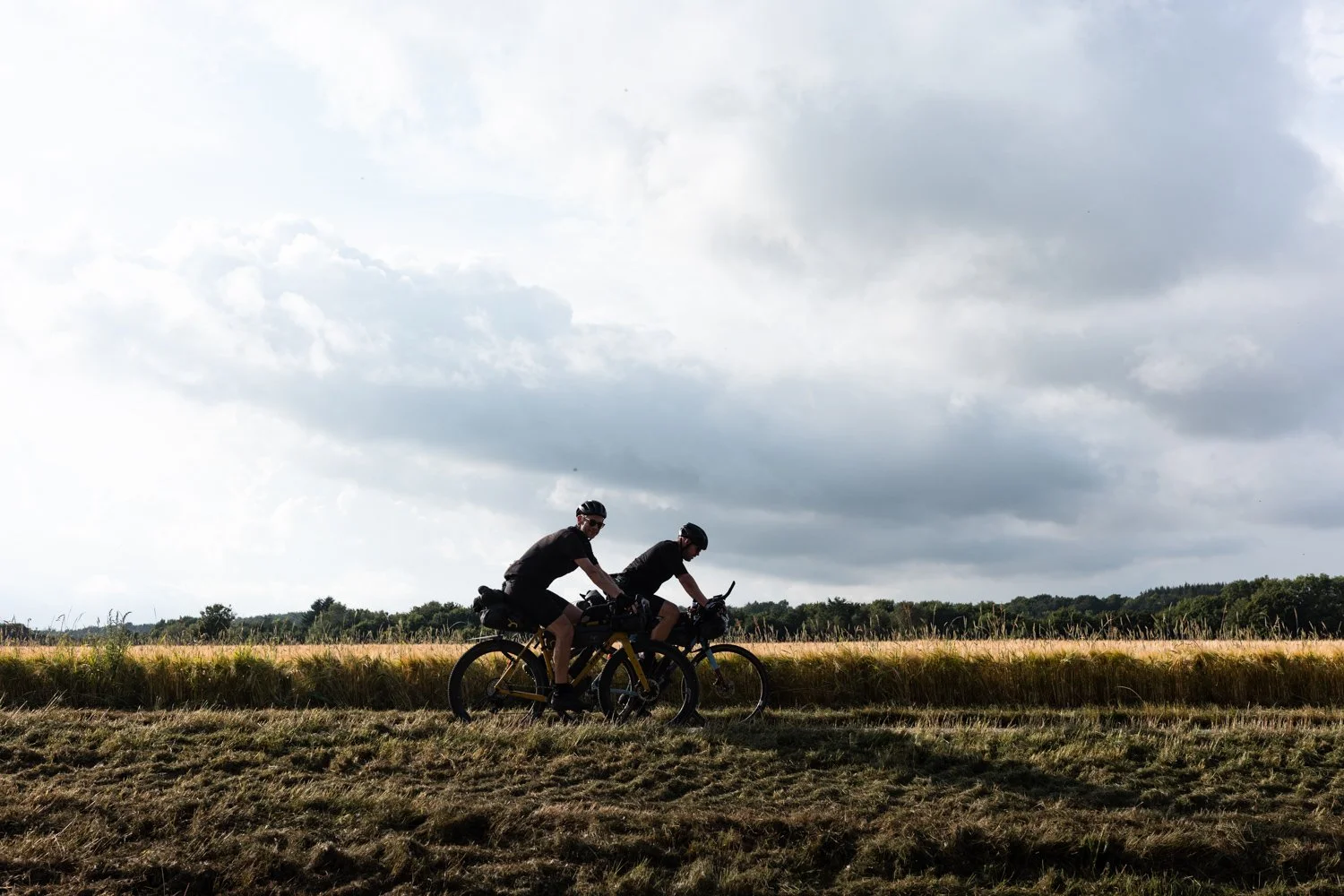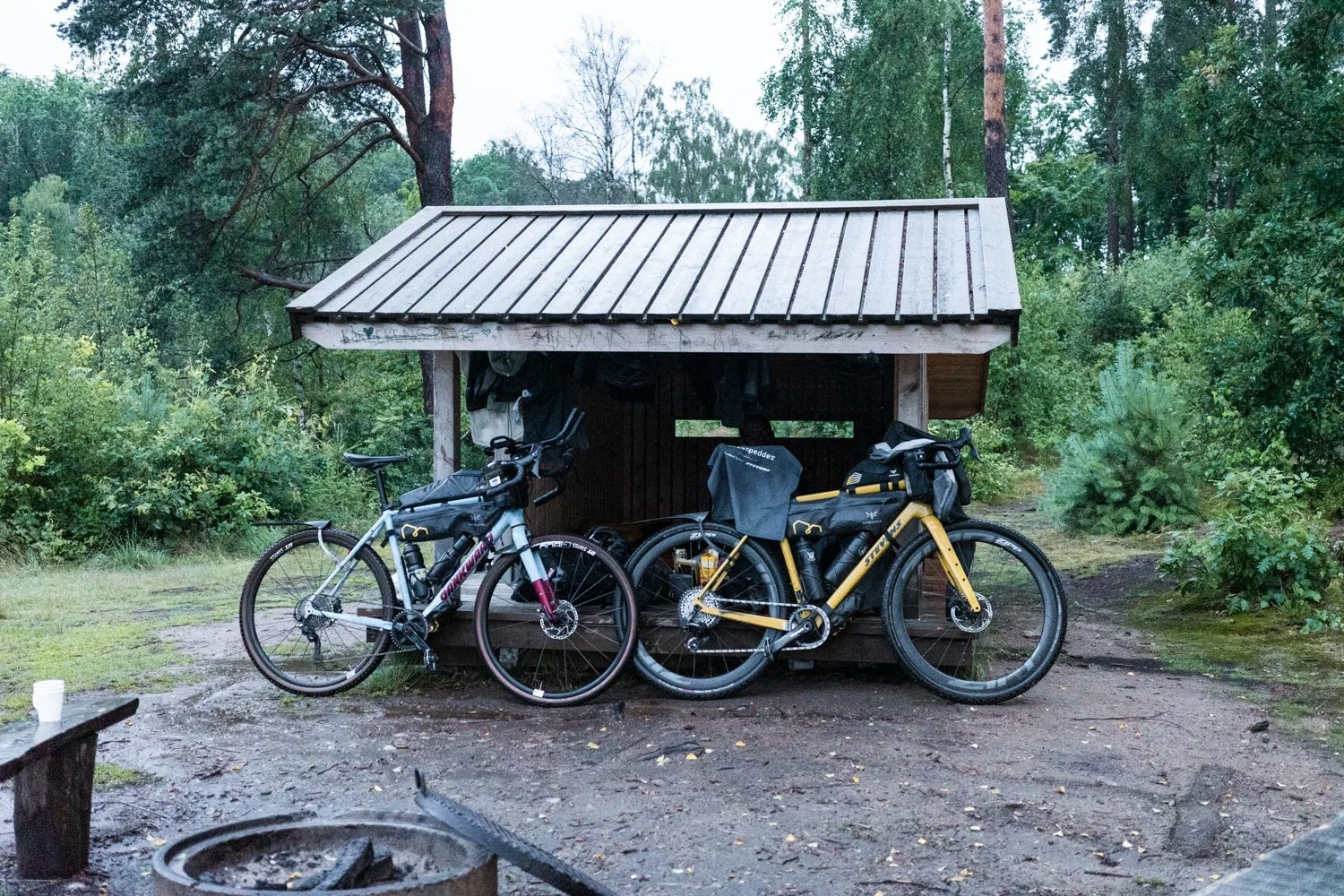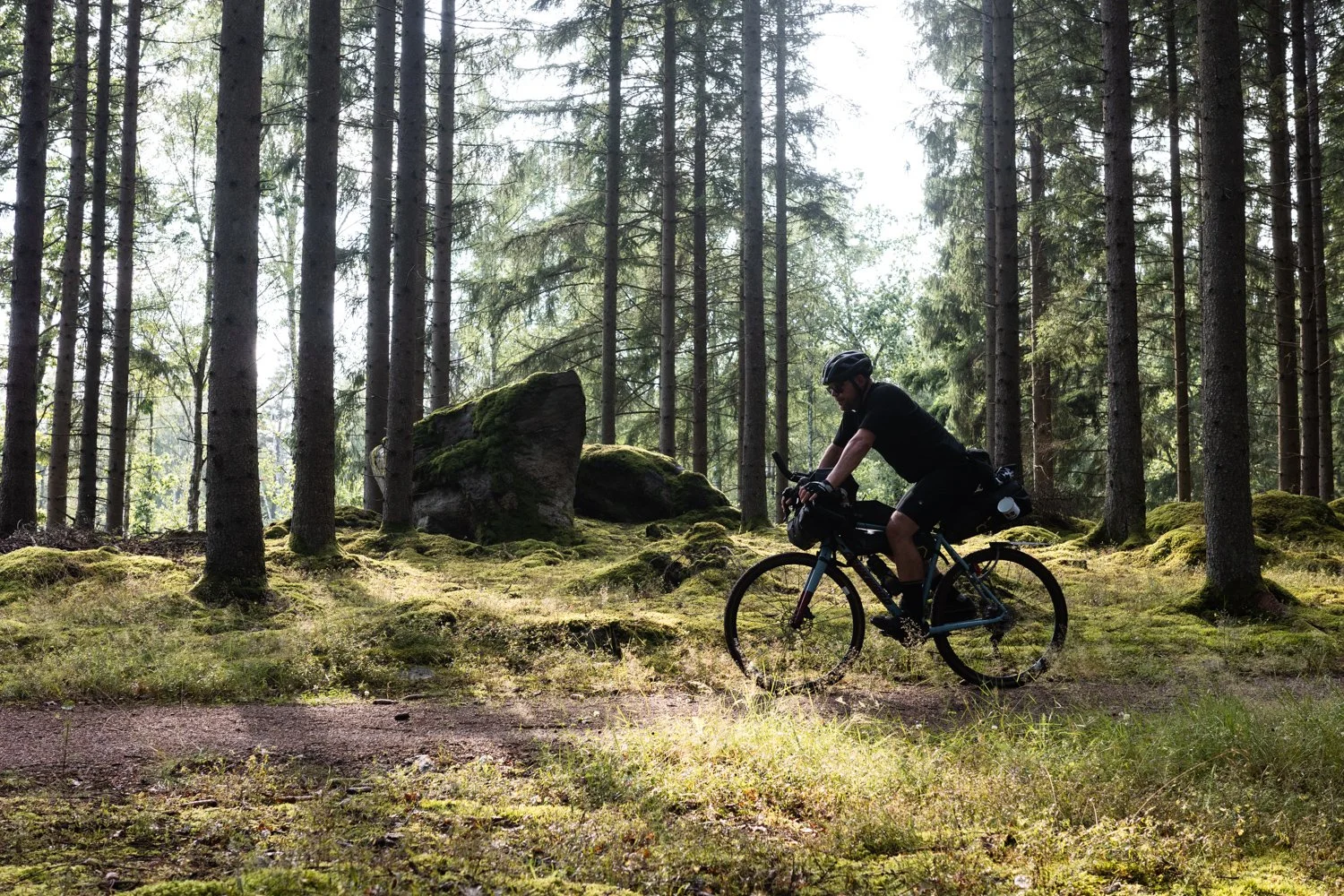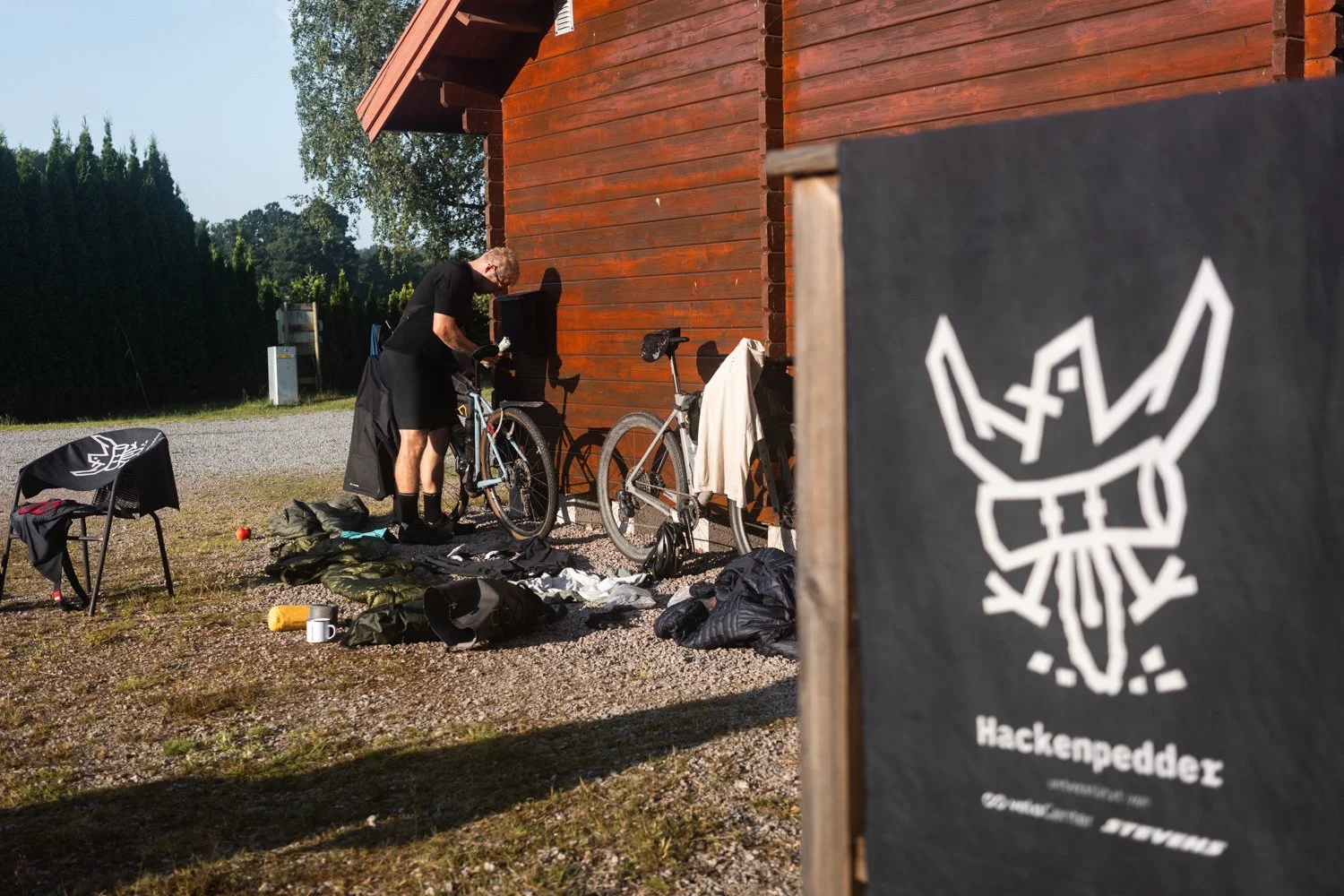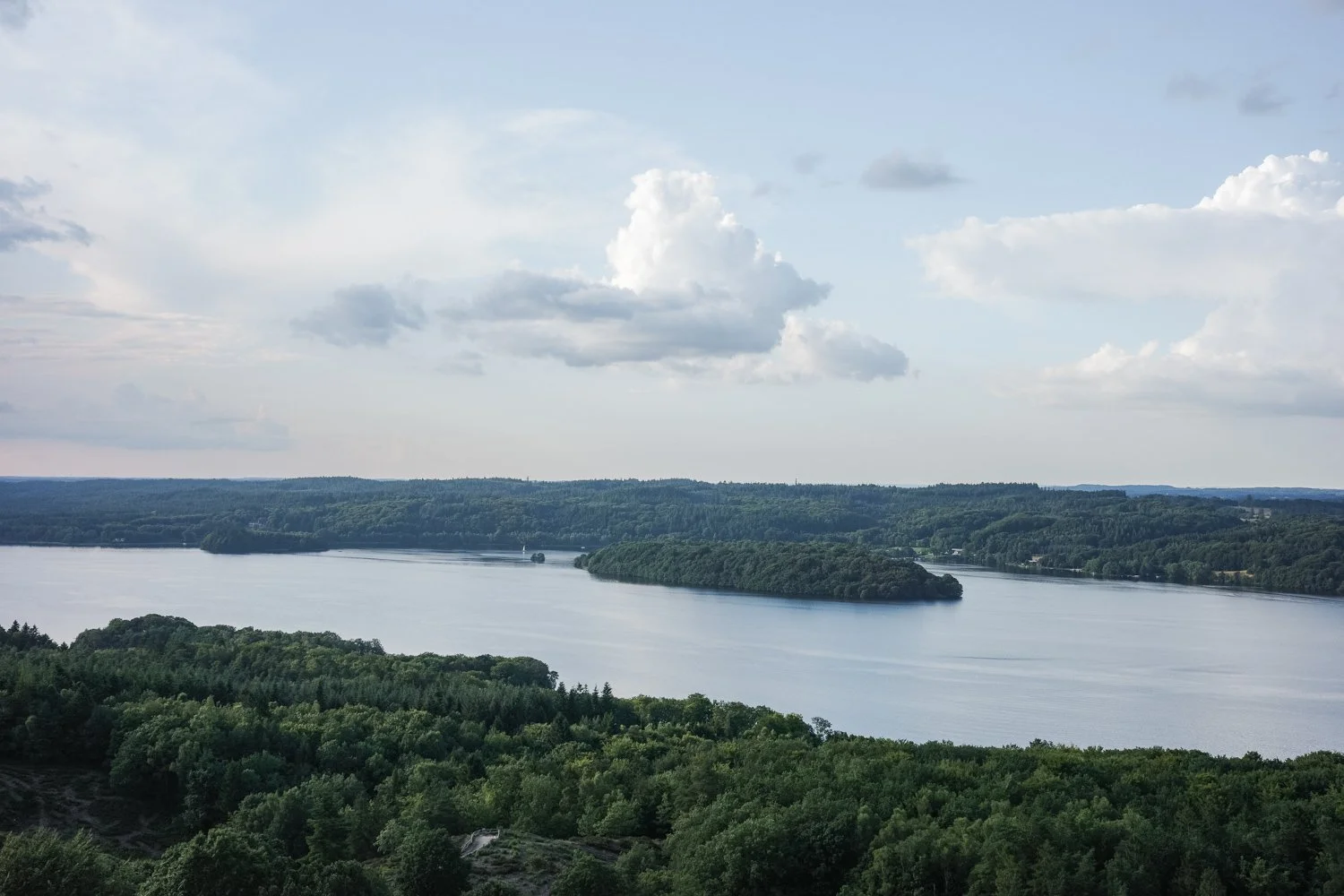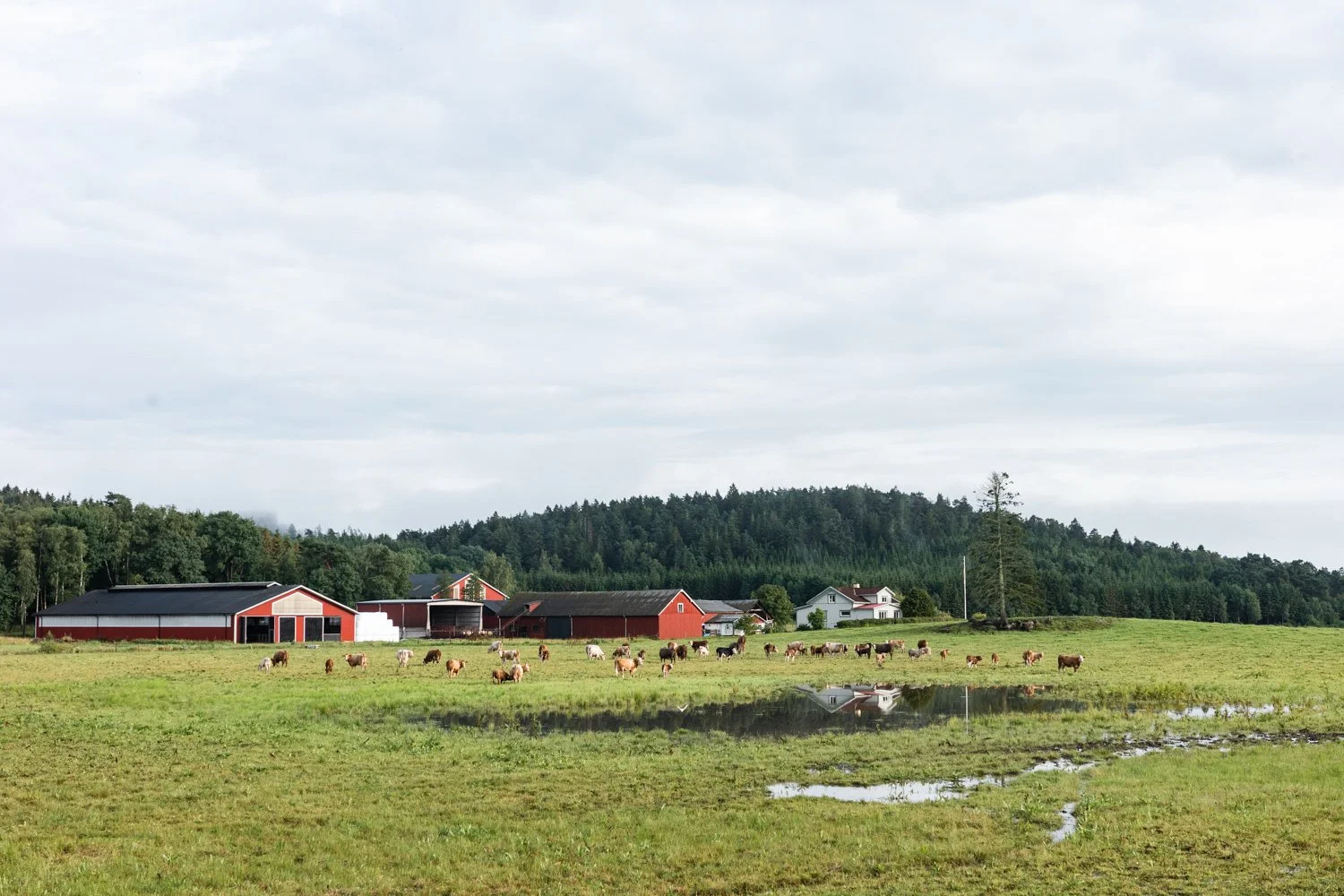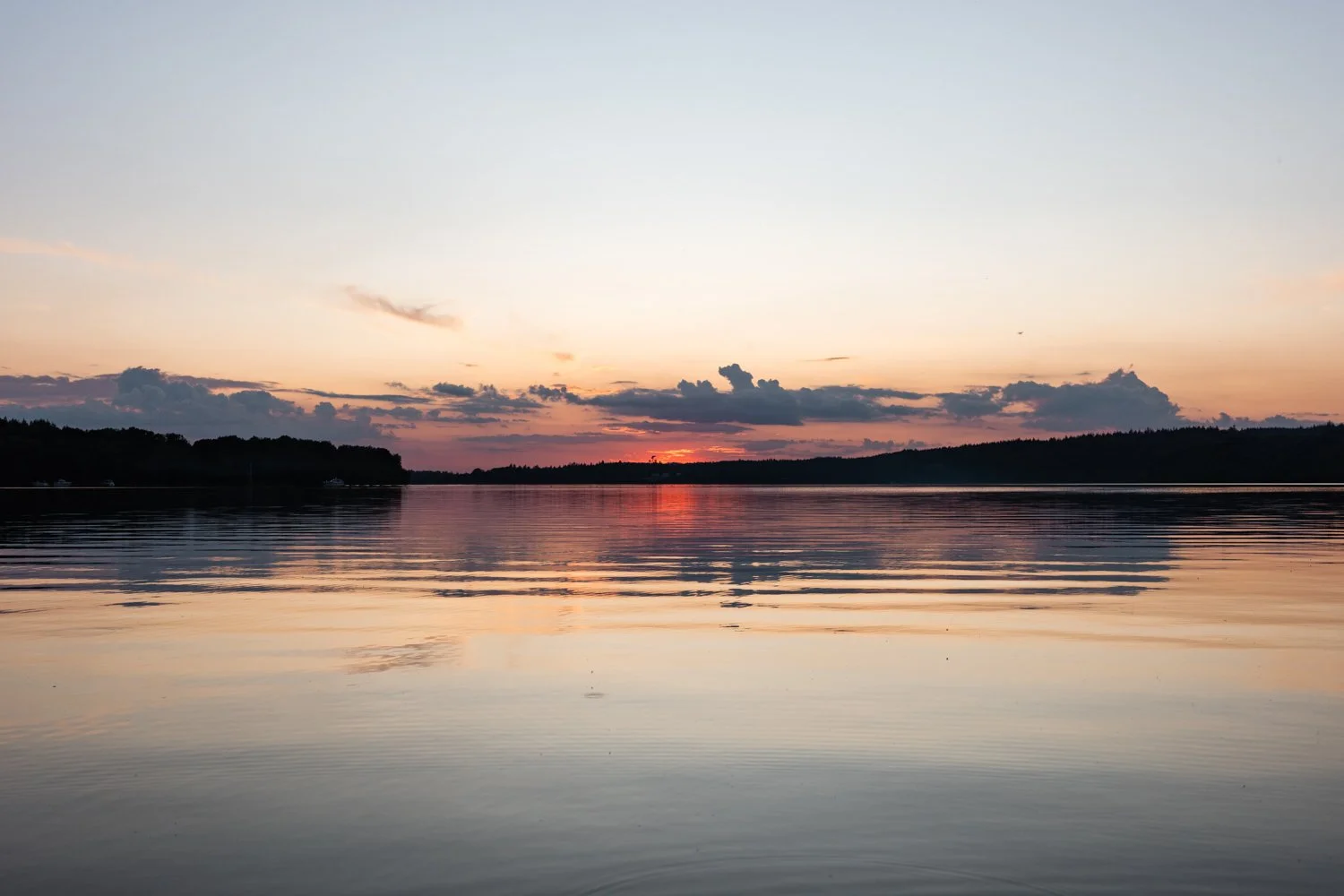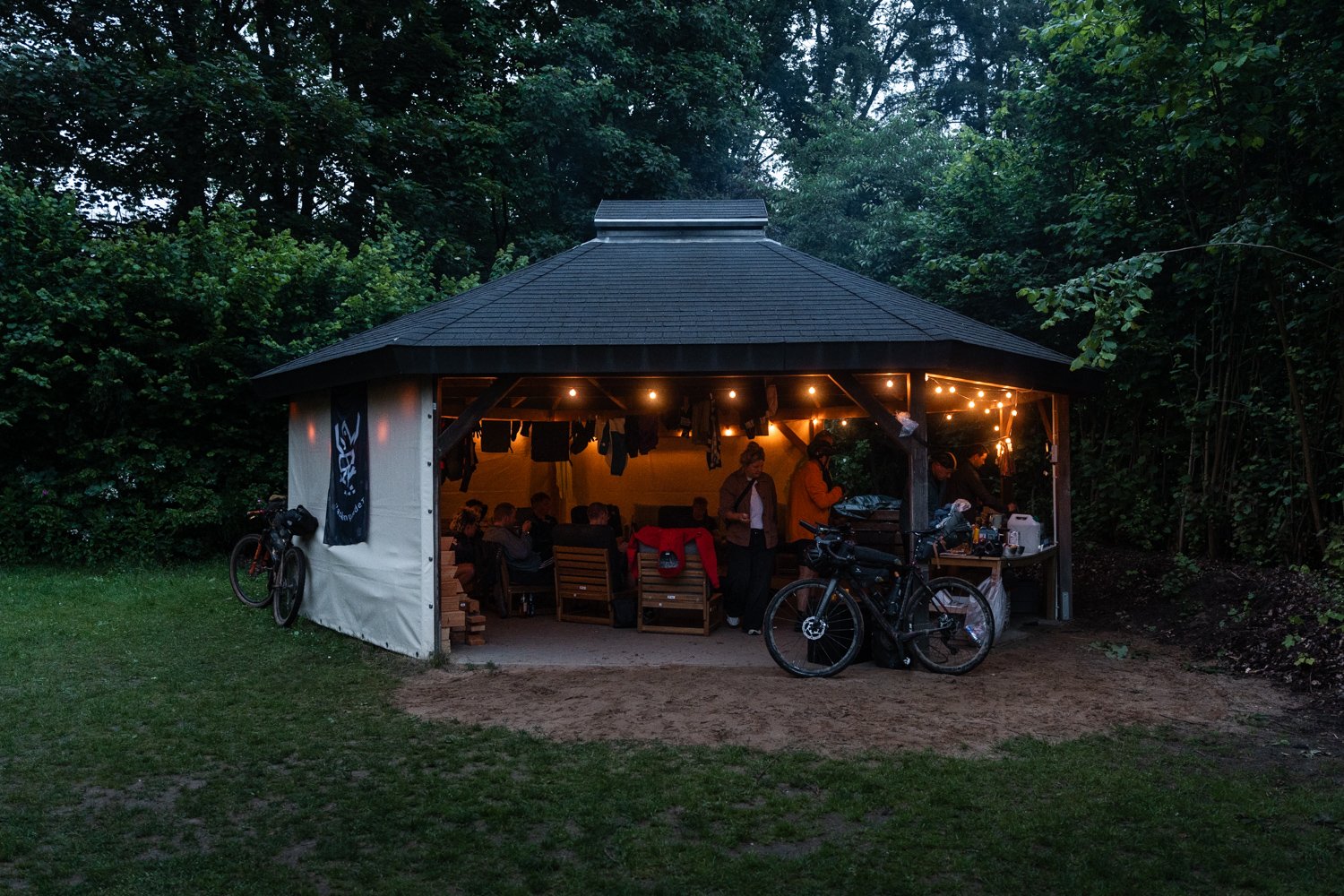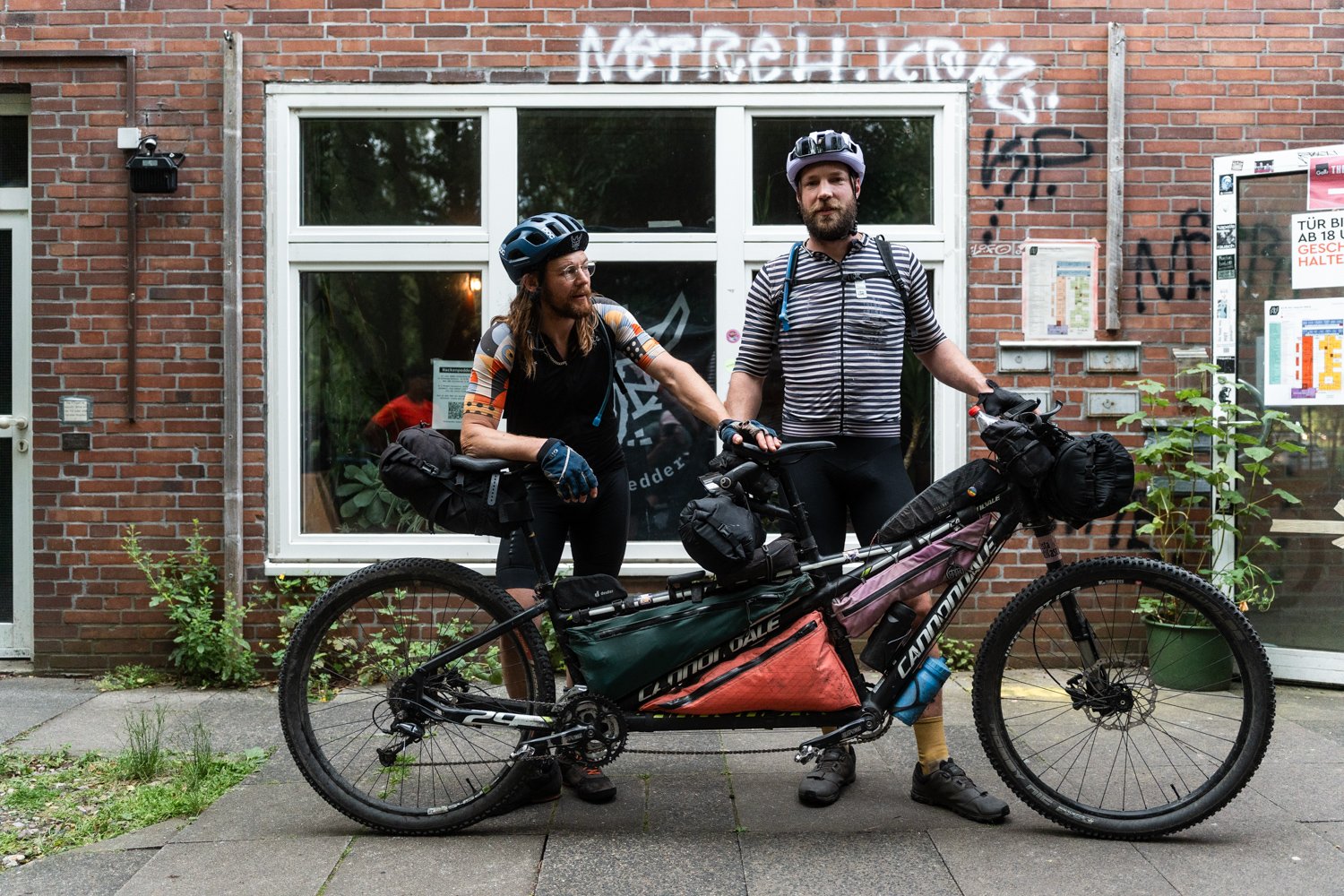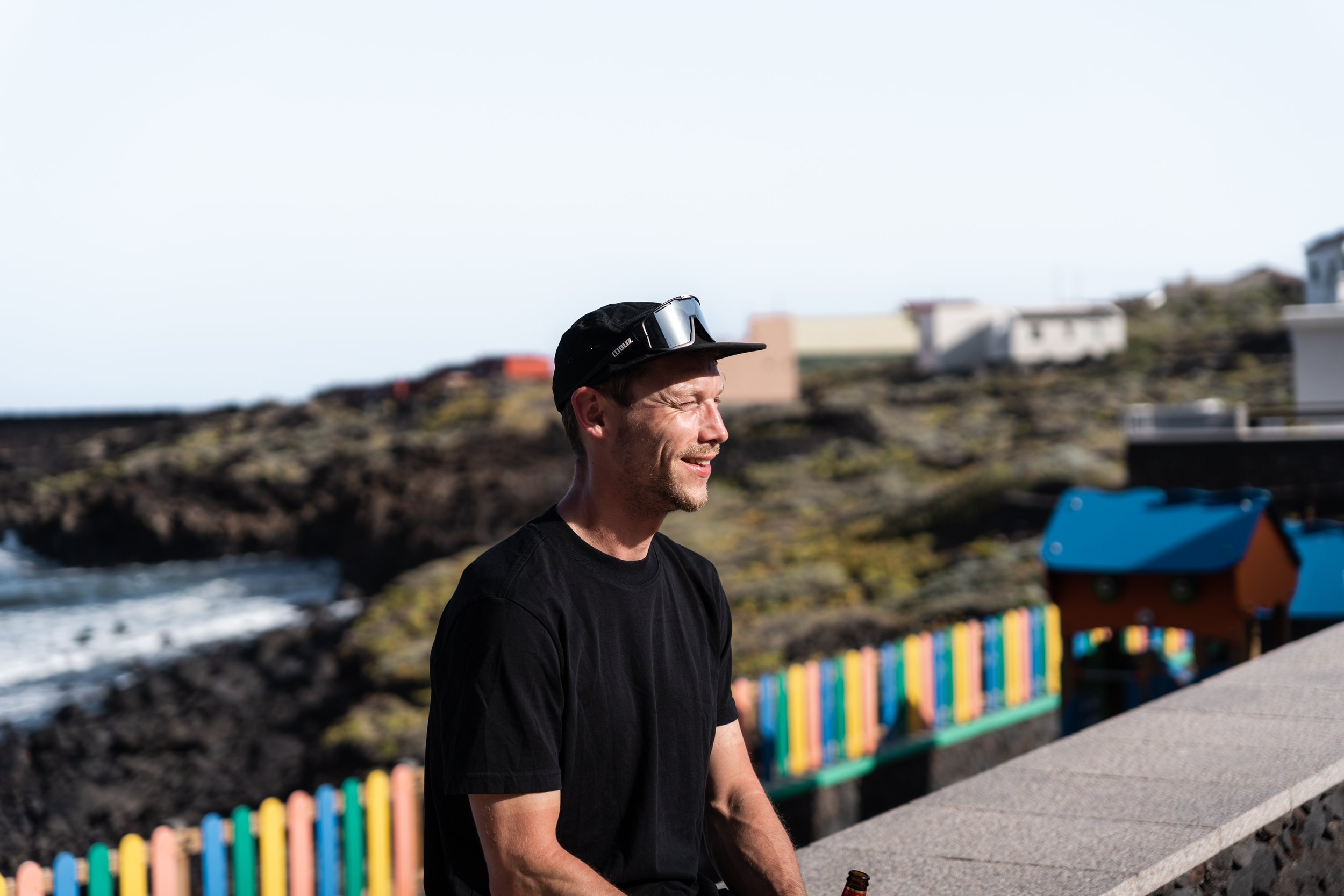Blog
God tur! 8 Tage Bikepacking durch Skandinavien
In diesem Reisebericht nehmen wir dich mit auf eine unvergessliche 8-tägige Bikepacking-Tour durch Dänemark und Südschweden. Zwischen Zimtschnecken, Regenschauern, Gravelpisten und Shelterplätzen entdecken wir die raue Schönheit des Nordens – authentisch und abenteuerlich. Ob Sitzprobleme, spontane Planänderungen oder magische Sonnenuntergänge – dieser Erfahrungsbericht gibt einen ehrlichen Einblick für alle, die Skandinavien mit dem Rad erkunden wollen.
Prolog: Flensburg nach Frederikshavn
Statt einfach die bequeme (aber auch teure) Nachtfähre von Kiel nach Göteborg zu nehmen, entschieden Gunnar, Nils und ich uns für die charmante Low-Budget-Variante: 400 Kilometer Radeln durch Dänemark bis nach Frederikshavn.
Gunnar und ich starten bereits am Sonntagabend von Kiel aus. Mit der Bummelbahn geht es von Kiel nach Flensburg und von dort ein paar Kilometer über die dänische Grenze zum Shelter in Kollund. Während Nils noch bei einer Familienfeier eingebunden ist, schlafen Gunnar und ich schon vor dem eigentlichen Start der Tour eine Nacht draußen.
Am nächsten Morgen stößt Nils dazu – frisch, motiviert, voller Tatendrang. Und so rollen wir drei los, die Sonne im Rücken, 185 Kilometer vor uns. Über Landstraßen und leichte Gravelabschnitte schiebt uns der Rückenwind gen Norden. Ein Höhepunkt am Nachmittag: Der Sukkertoppen (Zuckerhut) bei Skanderborg – ein dänischer "Gipfel" mit weiter Aussicht über Wälder, Windräder und Seen. Kein Hochgebirge, aber dennoch ein Moment zum Innehalten. Kurze Zeit später geht es noch höher hinaus: Der Himmelbjerget ist mit 147 m der höchste Punkt Dänemarks.
Kurz hinter dem Himmelbjerget werden wir belohnt mit einem idyllischen Shelter am Seeufer: goldene Abendsonne, kaltes Bier, und zum ersten Mal unser Standard-Abendessen für die kommende Woche: Bier, Brot mit Humus und Dosenfisch.
Tag 2: Regendusche und Sitzprobleme
Der zweite Tag startet wie ein milder Spätsommertag. Frische Luft liegt über dem See, die Sonne funkelt durch das Blätterdach.
Am frühen Nachmittag türmen sich dunkle Wolken am Horizont auf, dann peitscht uns der Regen frontal ins Gesicht. Innerhalb von Minuten sind wir durchnässt bis auf die Haut – trotz Regenjacken. Wir fluchen, lachen, radeln weiter. Eine Stunde und drei Hotdogs pro Kopf später ist die Welt wieder in Ordnung.
Weniger in Ordnung ist mein Hintern. Ein (relativ) neuer Sattel, vielversprechend aber nicht lange genug auf der Langstrecke getestet in Kombination mit einer billigen Bibshorts sorgte schon zu Beginn für Sitzprobleme. Nach Tag zwei: Sitzhölle. Irgendwas muss ich ändern, sonst muss ich die Tour abbrechen. Ich weiß nur noch nicht was.
Für den Abend ist wieder Regen vorhergesagt. Kurz vor Frederikshavn finden wir über die Shelter-App ein traumhaftes Plätzchen für die Nacht: Eine Hütte in einem wunderschönen botanischen Garten mit sauberen Sanitäranlagen und ruhig gelegen. Super! So müssen wir morgen kein Zelt abbauen und länger schlafen. Die Fähre geht ja schon um 8 Uhr und wir haben noch knapp zehn Kilometer zu rollen.
Am nächsten Morgen rollen wir frohen Mutes die letzten Kilometer zur Fähre. Im Kopf nur ein Ziel: das sagenumwobene Frühstücksbuffet.
Und es enttäuscht uns nicht: Pfannkuchen mit Marmelade, Rührei mit Speck, frischer Kaffee, Brötchen, Käse – ein kleines Festmahl auf hoher See.
Göteborg, Satteltausch und Zimtschnecken
Noch bevor die Fähre anlegt, kommt Gunnar mit einer Idee: Er hat zwei Bibshorts eingepackt, und vielleicht würde mir die andere besser passen. Ich bin über jede mögliche Lösung dankbar. Parallel suche ich nach einem Radladen mit Brooks-Sätteln – in der Hoffnung auf eine nachhaltigere Lösung. Und tatsächlich: keine zwei Kilometer vom Hafen entfernt finde ich einen Radladen, der meinen gewünschten Sattel führen könnte.
Obwohl eigentlich erst ab 16 Uhr geöffnet, ist der Besitzer schon im Laden – ein älterer Herr, wettergegerbtes Gesicht, weißer Rauschebarg, ruhige Stimme. Er hat nicht nur genau den Sattel vorrätig, den ich brauche, er montiert ihn auch direkt für mich. »Gewicht spielt keine Rolle, wenn du nicht bequem sitzt, macht es alles keinen Sinn«. Da hat er einfach Recht!
Als ich Gunnar und Nils wieder treffe, haben sie bereits eine riesige Zimtschnecke bestellt. Dazu noch einen Kaffee, dann sind wir abfahrbereit.
Vom Moor verschluckt und nackt in den See
Wir fahren erstmal raus aus der Stadt. Südlich von Göteborg wird die Landschaft wilder. Da die Infos auf Komoot teilweise sehr lückenhaft sind, habe ich mich bei der Routenplanung an der Strecke vom Radrace 96 Hours von vor ein paar Jahren orientiert. Vielleicht ein Fehler?
In einem Moorgebiet gehen wir fast verloren. Der Weg wird immer wilder, bald ist es nur noch ein Trampelpfad. Dann eine Bachquerung und plötzlich stehen wir mitten im Unterholz. Ein Weg? Der lässt sich höchstens erahnen. Für eine knappe halbe Stunde sind wir völlig orientierungslos – bis sich plötzlich ein Waldweg vor uns auftut. Erleichterung! Wir rollen weiter und nehmen vorsichtshalber häufiger mal die Landstraße, anstatt erneut ins Unterholz abzubiegen.
Der Regen lässt für ein paar Stunden nach und wir genießen die mystischen Wälder von Schweden, trotz des ständigen Auf und Ab kommmen wir gut voran. Am Abend erreichen wir das Dorf Skällinge. Mit unserer Ankunft setzt auch der Regen wieder ein. Unweit der Badestelle des Dorfes finden wir einen kleinen aber feinen Shelter. Gerade genug Platz für uns drei und mit einem eigenen Badesteg. Der Luxus, nicht im strömenden Regen unsere Zelte aufbauen zu müssen, hebt die Stimmung deutlich. Wir schlüpfen aus den verdreckten Radklamotten und hüpfen nackt in den See. Herrlich!
Abschied von Nils
Am nächsten Morgen scheint die Sonne in unseren Shelter. Wir breiten die Sachen zum Trocknen aus und packen entspannt unsere Sachen zusammen. Gunnar, der kurzfristig mit Schlauch fahren musste, flickt noch seinen Reifen, dann geht es los. Lange Schotterwege und einsame Landstraßen durch dünn besiedelte Gebiete warten auf uns. Um uns herum Märchenwald. So habe ich mir Schweden vorgestellt.
Doch dann erhält Nils einen Anruf: Familiärer Zwischenfall. Nichts lebensbedrohliches, aber er wird zuhause gebraucht. Nach nicht einmal der Hälfte der Tour müssen wir Abschied nehmen von ihm. Traurig und unerwartet – aber Familie geht natürlich vor, das ist klar.
Ab diesem Punkt sind Gunnar und ich zu zweit unterwegs. Die Dynamik ändert sich etwas. Wir sind zeitlich flexibler, haben also keinen Druck, ein bestimmtes Tagespensum zu schaffen.
Am Abend campen wir an einem wunderschönen Waldsee. Das Abendlicht ist magisch und spiegelt sich im Wasser. Nach dem abendlichen Bad im See und dem obligatorischen Feierabendbier fallen wir erschöpft in die Schlafsäcke.
Gravelparadies und ein überraschendes Gewitter
Am nächsten Morgen: Blauer Himmel und Sonnenschein. Keine Wolke weit und breit. Gegen Mittag fahren wir lange am Ufer des Åsnen entlang inklusive Badestopp. Danach folgen wir dem Mörrumsån auf seinem Weg in Richtung Süden.
In der Fernen hören wir schon den Donner grollen. Werden wir doch von einem Gewitter überrascht? Wenige Minuten später ergießt es sich über uns wie ein Sturzbach. Innerhalb kürzester Zeit sind wir wieder komplett durchnässt. Eine Stunde später, als wir gerade nach Olofström einrollen, ist die erste Gewitterfront durchgezogen. Während der zweiten Regendusche wärmen wir uns in einem typischen schwedischen Pizza-Imbiss auf. Die Pizza wie immer üppig belegt und schön fettig.
Als die Sonne wieder herauskommt geht es für uns weiter. Während die Feuchtigkeit noch dampfend aus dem tiefgrünen Moos emportsteigt rollen wir über urige Trails in das Halens Naturreservat. Die Wege sind von rutschigen Steinen übersäht, anfangs noch recht gut fahrbar, wird der Abstecher irgendwann zu einem Hike-a-bike. Die magische Atmosphäre nach dem Regen und die abwechslungsreiche Natur macht die Anstrengungen jedoch wieder wett.
Wir fahren ein paar Schlenker durch die Naturschutzgebiete und gegen Abend erreichen wir das Ufer des Immeln. Wir sind im abosulten Gravelparadies angekommen. Endlose, sich durch die Landschaft schlängelnde Schotterstraßen ohne, dass wir auch nur einem Auto begegnen.
Nach 180 km wollen wir eigentlich einen Shelterplatz direkt am See ansteuern. Dieser ist jedoch durch ein mürrisches schwedisches Pärchen belegt, das sich nicht wirklich über unsere Gesellschaft zu freuen scheint. Da auch die Badestelle dort nicht so einladend ist, fahren wir noch ein paar Kilometer weiter zu einem Kanucamp, wo wir nicht nur eine schöne Zeltwiese sondern auch endlich eine Steckdose für unsere Powerbanks finden.
Tag 6: Eine unerwartete Wanderung
Highlight heute: Der Söderåsen Nationalpark. Wie immer, wenn es bei Komoot wenig Infos gibt, weiß man natürlich nicht, was einen erwartet. Anfangs rollen wir noch recht entspannt, doch bald wird der Pfad immer technischer, irgendwann zu einem steilen Anstieg, dann zum Kletterabschnitt. Wir schleppen unsere Bikes über umgekippte Bäume, stemmten uns gegen Äste, fluchen von uns hin. Oben angekommen, erschöpft, öffne ich meine Tasche – die Schokolade, die ich mir als Belohnung gönnen will: geschmolzen, ausgelaufen, verteilt über Technik und Kleidung. Es ist zum heulen!
Nachdem der Ärger verpufft ist, sammeln wir neue Motivation. Die Wanderung im Nationalpark hat uns viel Zeit gekostet, aber wir kommen trotzdem gut voran. Wir entscheiden uns, heute noch die Fähre von Helsingborg nach Helsingør zu nehmen. Dänemark hat uns wieder.
Dänisches Finale: Schlösser, Schnurgerade landstraßen und Hitze
Zurück in Dänemarks ändert sich das Bild wieder: Felder, leichte Hügel, schnurgerade Straßen. Wir kommen an zwei imposanten Schlössern vorbei: Schloss Fredenborg und Schloss Frederiksborg. Die Prachtbaute sind ein schöner Tapetenwechsel zum Wald, durch den wir die letzten Tage gefahren sind, Wir durchqueren Roskilde mit seiner ehrwürdigen Altstadt und spulen die letzten Kilometer herunter. Ab einem gewissen Punkt hilft nur noch Musik auf den Ohren. Am Abend erreichen wir Falster. Wir schlagen unser Zelt auf einem Shelterplatz neben einer Kiesgrube auf. Morgen nur noch gut 150 km bis Kiel!
Tag 8: Heimweg bei Nieselregen
Der letzte Tag beginnt nass. Schon gegen 4 Uhr in der Früh höre ich den Regen auf mein Zelt prasseln. Eine kurze Regenpause nutzen wir, um die Sachen einzupacken, fahren dann über Falster und Lolland nach Rødbyhavn. Die Fähre bringt uns zurück nach Deutschland, nach Fehmarn, das sich als flach und trist herausstellt. Der Regen verschont uns zum Glück weitestgehend. Immer mal wieder tröpfelt es, ansonsten: Drückende Schwüle, grauer Himmel, Gewitterfliegen im Gesicht. Die letzten Kilometer sind zäh. Als wir endlich in Kiel ankommen, freuen wir uns nur noch auf die Dusche.
Fazit: Schokolade schmilzt, Erinnerungen bleiben
1.397 Kilometer, 8 Tage, ca. 8.500 Höhenmeter. Unterm Strich: eine grandiose Tour mit viel Schweiß, viel Sonne, etwas Regen und unzähligen Zimtschnecken. Körperlich hart aber noch im Genussbereich, landschaftlich vor allem in Schweden spektakulär. Insgesamt ein unvergesslicher Bikepacking Trip.
Bestes Land: Schweden. Natur pur. Seen, Wälder, Gravel vom Feinsten.
Lessons learned: Weniger ist mehr. Weniger Kilometer = mehr Genuss.
Schönster Moment: Nackt baden im Regen.
Unschönster Moment: Schokolade in der Rahmentasche.
Nächstes Mal: von Göteborg in Richtung Norden. Dalsland ruft!
»Über Trassen und Halden« ins neuen LifeCycle Magazin
Im aktuellen LifeCycle-Magazin berichte ich von unserer Teilnahme am ersten Ride Around The Ruhr – einem 600 Kilometer langen Gravel-Abenteuer durchs Ruhrgebiet. Zwischen staubigen Schotterpisten, legendären Halden und industriekulturellem Charme haben wir nicht nur überraschend viel Natur entdeckt, sondern auch unsere Grenzen. Und wie es sich anfühlt, wenn ein Förster mitten in der Nacht dein Nachtlager findet? Das lest ihr im Artikel.
Im aktuellen LifeCycle-Magazin berichte ich von unserer Teilnahme am ersten Ride Around The Ruhr – einem 600 Kilometer langen Gravel-Abenteuer durchs Ruhrgebiet. Zwischen staubigen Schotterpisten, legendären Halden und industriekulturellem Charme haben wir nicht nur überraschend viel Natur entdeckt, sondern auch unsere eigenen Grenzen. Und wie es sich anfühlt, wenn ein Förster mitten in der Nacht dein Nachtlager findet? Das lest ihr im ersten Heft der Neuauflage des Magazins.
Mediateam beim Hackenpedder 2025
Am zweiten Juniwochenende startete das »Hackenpedder« Bikepacking Event in sein drittes Jahr. 160 Fahrer(innen) waren am Start in Kiel um Schleswig-Holstein auf 1000 km (bzw. 600 km auf dem Shortcut) kennenzulernen. Zusammen mit Gunnar Dethlefsen habe ich das Event als Mediateam über mehr als vier Tage begleitet.
Am zweiten Juniwochenende startete das »Hackenpedder« Bikepacking Event in sein drittes Jahr. 160 Fahrer waren am Start in Kiel um Schleswig-Holstein auf 1000 km (bzw. 600 km auf dem Shortcut) kennenzulernen. Zusammen mit Gunnar Dethlefsen habe ich das Event als Mediateam über mehr als vier Tage begleitet.
Start
Am Vorabend des Starts hatte unser Partner VeloCenter zu einem Community Abend eingeladen. Wer wollte konnte sich registrieren oder einfach bei einem kühlen Getränk oder leckeren Snack mit Gleichgesinnten vernetzten. Am nächsten Morgen dann ging es los. Bei schönstem Sonnenschein versammelten sich alle abenteuerlustigen Teilnehmer voller Vorfreude auf den gemeinsamen Start um 10 Uhr.
Kurz danach ging es für Gunnar und mich auch auf die Straße. Etwas außerhalb der Stadt wollte Gunnar auf einer schönen Schotterstraße möglichst viele Fahrer ablichten während ich im Auto das Instagram-Reel vom Start schnitt. Es ist als Media Team unmöglich alle Teilnehmer gleichermaßen zu fotografieren. Meist trifft man die schnelleren 10% des Feldes immer wieder. Das liegt daran, dass auch wir einen Zeitplan haben den wir verfolgen. Da können wir nicht an jedem Spot solange warten bis das gesamte Feld vorbeigezogen ist. Aus diesem Grund sollten zumindest zu Beginn, jeder ein Foto von sich haben.
Friedwald an der Steilküste
Weiter ging es zum Friedwald an der Steilküste bei Weissenhaus, ein idyllischer Ort wie aus dem Bilderbuch. Trotz der Mittagszeit war das Licht wunderschön und wir konnten uns fotografisch richtig austoben.
Plöner See
Wir lagen gut in der Zeit. Die sommerlichen Temperaturen sorgten dafür, dass das Tempo der Teilnehmer nicht zu hoch war. Da auch wir ganz schön ins Schwitzen gekommen waren, machten wir einen kurzen Badestopp in Bosau am Plöner See. Gut erfrischt zogen wir dann zu einer Gruppe von Halbinseln am Seeufer weiter, wo wir die Fahrer in der typischen holsteinischen Landschaft einfangen konnten. Hier hörten wir schon die ersten Anekdoten von größeren Defekten und dem Kampf gegen die Hitze.
Checkpoint 1
Gegen Abend zogen wir weiter in Richtung CP1 am Camp Wakenitz, einem idyllisch gelegenen Campingplatz für Kanuwanderer direkt am gleichnamigen Fluss. Die Sonne stand schon tief als wir dort ankamen und die ersten Fahrer waren schon angekommen, gut gezeichnet von den über 200 km und der Hitze.
Nils hatte uns dankenswerterweise eine ziemlich luxuriöse Unterkunft organisiert: Ein kleines Fass mit zwei sehr bequemen Betten mitten im Camp. Wenn man noch Reels zu schneiden und Fotos zu bearbeiten hat, ist man tatsächlich über jeden Handgriff dankbar, den man nicht machen muss. Gegen 23 Uhr fielen wir nach einem 15-Stunden-Tag erschöpft in die Federn und schliefen sofort ein.
Tag 2: Das Grenzgebiet
Um kurz nach 6 Uhr klingelte am nächsten Morgen der Wecker. Die meisten Fahrer waren schon auf den Beinen, nicht wenige auch schon aufgebrochen. Wir fingen noch die Morgenstimmung am Checkpoint ein, dann packten auch wir unsere Sachen. Tag zwei stand ganz im Zeichen der alten deutsch-deutschen Grenze.
Unser erste Ziel war ein scheinbar endloser Schotterweg, der exemplarisch für die weite, dünn besiedelte Natur im alten Grenzgebiet stehen sollte. Gunnar entdeckte einen wenig vertrauenserweckenden Hochstand, den wir wagemutig erklommen. Von hier aus entdeckten wir nicht nur den einen oder anderen Fahrer, sondern auch einen Storch, der ungestört durch das hohe Gras wartete.
Auch in den Ortschaften sieht man heute noch den Unterschied zwischen Ost und West. In vielen Dörfern ist seit der Wende nicht viel passiert. Die Route führt durch das Dorf Lassahn. Dort wollten wir den typischen »Ost-Charme« einfangen.
Wenn man sich mit der Geschichte des geteilten Deutschlands beschäftig, kommt man nicht vorbei an den Dramen, die sich an der Grenze abgespielt haben. Mit dem Denkmal für Michael Gartenschläger wollten wir einen dieser geschichtsträchtigen Orte entlang der Route mit einfangen. Für mich, als Sohn einer ostdeutschen Mutter und eines westdeutschen Vaters, berühren mich diese Orte immer sehr. Ich war froh, dass Nils dem Thema in unser Medienarbeit so viel Raum eingeräumt hat und es als ebenso wichtig erachtete.
Passend zur Stimmung kam es wenig später zu einem Wetterumschwung. Ein großes Tiefdruckgebiet mit Starkregen zog über Hamburg und Schleswig-Holstein hinweg. Schnell fuhren wir noch nach Boizenburg um vor dem großen Regen ein paar Aufnahmen zu machen. Kurze Zeit später goss es wie aus Eimern. Wir saßen zum Glück zu diesem Zeitpunkt im trockenen Auto auf dem Weg nach Lauenburg, ein kleines Städtchen direkt an der Elbe mit historischer Altstadt und direkt am Dreiländereck. Da wir dort nur noch wenig Teilnehmer »erwischten« entschlossen wir uns, in Richtung CP2 aufzubrechen.
Checkpoint 2
Den Abend und die zweite Nacht verbrachten wir am uns schon bekannten Checkpoint 2 auf dem Zeltplatz in Wittenborn. Wir hatten Glück und hatten fast den gesamten Zeltplatz für uns allein. In der Hütte brannte schon ein gemütliches Lagerfeuer und die Fahrer, die den Regen voll abbekommen hatten trockneten ihre Sachen. Nicht nur die Teilnehmer – auch das eine oder andere Rad hatte sich eine Dusche redlich verdient. Nach einem ordentlichen Bananenbrot-Abendessen und nach getaner Arbeit zogen wir uns in unser Zelt zurück.
Tag 3: Dithmarschen und die Westküste
Der dritte Tag sollte am Ende der längste und anstrengendste werden. Unser erstes Tagesziel war der Breitenburger Kanal. Auf fünf Kilometern Grasnarbe durch den Wald werden die Fahrer durchgeschüttelt bevor sie bei einer alten Kreidegrube ausgespuckt werden. Was gibt es schöneres als dort vom Mediateam empfangen zu werden?!
Da wir schon in der Stimmung für gemeinen Untergrund waren, fuhren wir gleich ein paar Kilometer weiter zur Binnendüne Nordoe, wo die Teilnehmer endlich auf den berühmt-berüchtigten Zuckersand trafen.
Bei Brokdorf am stillgelegten Kraftwerk verläuft die Route zwischen Deich und Elbe. Schafe, Wiese, weiter Horizont – hier bekommt man schon mal einen Vorgeschmack auf die Westküste.
Da wir gut in der Zeit lagen, entschlossen wir uns kurzerhand noch an die Westküste zu fahren. Die Gegend ist fotografisch eher uninteressant, sodass sowohl Gunnar als auch ich, diesen Tagesordnungspunkt gerne hinter uns bringen wollten. Da sich das Fahrerfeld eher ausgedünnt hatte, mussten wir (wie zum Beispiel im Städtchen Friedrichstadt) recht lange auf unsere Motive warten.
Tag 4: Aukrug, Kanal und Ziel
Nach den ersten langen drei Tagen, teils mit langen Autofahrten, waren wir nicht böse an Tag 4 mal »um die Ecke« den Tag zu beginnen. Die Wälder im Aukrug sind ein super idyllischer Ort und perfekt zum Graveln. In der Nähe des Übernachtungsplatzes, unweit des Flüsschen Bünzau gingen wir auf die Pirsch.
Aus dem Film vom Vorjahr ist der Boxberg bereits bekannt. Nur fotografiert hatte ich hier noch nicht. Ein paar kämpferische Gesichter wollten wir dort noch einfangen.
Der NOK (Nord-Ostsee-Kanal) muss zweimal überquert werden. Da es ein künstlich angelegtes Gewässer ist, müssen kostenlose Fähren angeboten werden.
Wenig später ging es für uns dann zurück nach Kiel, denn immer mehr Fahrer erreichten das Ziel an der »Alten Mu«.
Finisher Party
Nach all den vollen Tagen wollten wir am Freitag dann nochmal die schönen Erinnerungen Revue passieren lassen. Hier fiel es mir besonders schwer noch die Kamera hin und wieder drauf zu halten. Es macht zwar unheimlich viel Spaß, das Event zu begleiten aber die Kamera steht halt auch häufig zwischen einem selbst und dem Gegenüber oder ist zumindest eine Ablenkung. Obwohl ich an dem Abend eher dann nochmal mit dem einen oder anderen Teilnehmer in Ruhe reden wollte, sind trotzdem noch ein paar gute Bilder entstanden.
Hackenpedder 2024 – Der Film
Hackenpedder is a lovingly organized bikepacking event with and for the community, which runs around Schleswig-Holstein. The route stretches for approximately 1,000 km and offers diverse landscapes, including cliffs, gravel roads, and dikes. Hackenpedder is aimed at both beginners and experienced riders who want to test their limits.
Hackenpedder ist ein liebevoll organisiertes Bikepacking-Event in Schleswig-Holstein mit und für die Community. Die Route erstreckt sich über rund 1.000 km und bietet abwechslungsreiche Landschaften, darunter Steilküsten, Schotterwege durch urige Wälder und schnurgerader Asphalt entlang der Deiche an der Nordseeküste. Hackenpedder richtet sich sowohl an Anfänger als auch an erfahrene Bikepacker, die ihre Grenzen austesten möchten. Ich war einige Tage mit Gunnar entlang der Route unterwegs, um das Event zu dokumentieren. Das war eine ziemliche Herausforderung, da die Teilnehmer über das ganze Bundesland verteilt waren und wir nicht wussten, wo genau sie sich während des Events befanden. Herausgekommen ist kleiner aber feiner Film, der euch einen Eindruck von Stimmung und Strecke geben soll. Viel Spaß beim schauen! Lasst gerne ein Like und Abo da.
Family on board – Sailing from Spain to Madeira
Traveling for more than one year on a sailing boat? What sounds like a dream to most people became reality for my friends Nico and Theresa with their baby »Joni«. I had the honor to travel with them and another friend for more almost a month, sailing from southern Spain to Morocco and later to Madeira.
Traveling for more than one year on a sailing boat? What sounds like a dream to most people became reality for my friends Nico and Theresa with their baby »Joni«. I had the honor to travel with them and another friend for almost a month, sailing from southern Spain to Morocco and later to Madeira.
Our home for the next 4 weeks: A Beneteau First 36.7
After meeting up in a marina close to Malaga (Spain), we made the boat ready for our first crossing. Across the teal waters of the Mediterranean Sea, we headed towards Morocco. With a short stop at Ceuta, an autonomous city of Spain located on the northern coast of Africa, we arrived in Tangier (Morocco) a day later.
The most important job on the boat: Entertaining the smallest passenger
Checking the weather and navigation tool to find the best time to leave the harbor
For us, it was the first time being in Morocco. Despite being just a few nautical miles away from Europe, the cultural differences are huge. Here, we felt like diving directly into the array culture. Morocco has a rich cultural heritage that reflects both Arab and Berber influences. We spent the days strolling across the city, with its winding alleys and busy markets. We had a lot of coffee, sweet mint tea, and, of course, »Tajin« the traditional steamed dishes.
After almost a week, it was time for us to move on. For the crossing to Madeira, we had to cover 550 nm (about 1000 km). The wind seemed rather low, but enough to travel at a comfortable speed. For 3.5 days, there were only the five of us, the boat, and the ocean. The sun set and rose again and again while we were living according to our watch schedule.
Enjoying the end of the first day on board with a beautiful sunset
Care work
Elegant accompaniment: Once in a while, these beautiful animals were following us
Then we finally arrived at Madeira, or better, at Porto Santo, its sister island. Before heading over to the main island, we stayed there a few days and got used to life on land again.
Madeira really surprised me. The strong contrast between arid, rocky cliffs and lush green forests was just insane. We traveled to the famous »Fanal« with its rustic trees in the foggy weather. We watched the sunrise at the very northern peak of the island, close to our anchor spot. We went snorkeling in the crystal-clear water next to our boat. We hike up the typical »Levadas«, artificial streams built to move water for agriculture.
Sunrise close to Miradouro de São Lourenço
Cave on Porto Santo
The days flew by, and when I had to fly back home, I was feeling like I could have stayed here for weeks. One thing I know for sure: I will come back. But will I get there by sailing? Probably, this was a unique experience.
Hiking up the »Levada«
Adventure Talk – Sharing my experiences with you
“Happiness is only real when shared” – there is a lot of truth in this well-known quote from “Into The Wild”. Many adventures are associated with hardships
“Happiness is only real when shared” – there is a lot of truth in this well-known quote from “Into The Wild”. Many adventures are associated with hardships. To speak of real joy during the events is usually not quite accurate. So, it's usually the overall experience in retrospect and the associated increase in experiences that makes you remember the experience as meaningful and positive. For me, of course, there is also the fact that as a photographer I not only want to share my stories about the ultra-distance bikepacking events, but of course I also want to present my photos. The new talk format in Kiel called “Adventure Talk” was of course the perfect occasion. The concept was created by Robin from Café9, also co-founder of the Kiel Dawn Patrol, an established racing bike community. In the audience I was pleased to see some well-known faces from the scene but also many other aspiring athletes. In advance, Marei Moldenhauer talked about her impressive performance at the Transcontinental Race. Overall, a very inspiring and excellently organized evening. I'm already looking forward to a continuation of the series.
Holy Gravel — The trinity of doom tracing the Apostels
»Holy Gravel« is a non-commercial Gravel event starting and finishing in Hamburg. It’s know for it’s high percentage of gravel, single trail and sandy sections, leading you through the most beautiful parts of north-eastern Germany. The event offers two routes: a shorter one accounting for 550 km and a longer 750 km ride. Nils, Gunnar and me had chosen the short one, since we only had three days to finish the track due to family responsibilities.
»Holy Gravel« is a non-commercial Gravel event starting and finishing in Hamburg. It’s known for it’s high percentage of gravel, single trail and sandy sections, leading you through the most beautiful parts of north-eastern Germany. The event offers two routes: a shorter one accounting for 550 km, and a longer 750 km ride. Nils, Gunnar and me had chosen the short one, since we only had three days to finish the track due to family responsibilities. We didn’t really know what to expect, so we were curious and open-minded for a three day adventure with a lot of riding, impressive landscapes and sleeping in a bivy outdoors.
Day 1
Together with approximately 200 riders we started on a Saturday morning. Soon, we left the city traffic of Hamburg and headed towards the suburbs. After the first 30 km riding in a big group with a few traffic jams, we decided to get ahead of the group.


After a short »sprint«, we found ourself alone in the rural area of Herzogtum Lauenburg. From now on, we would very rarely ride on paved roads. The track leads along the many lakes of the area and after about 95 km we arrived in Ratzeburg where we decide to take a longer lunch break for fish and chips.
In the afternoon, we crossed the former border region between West and East Germany, the so called death strip, on sandy single trails.
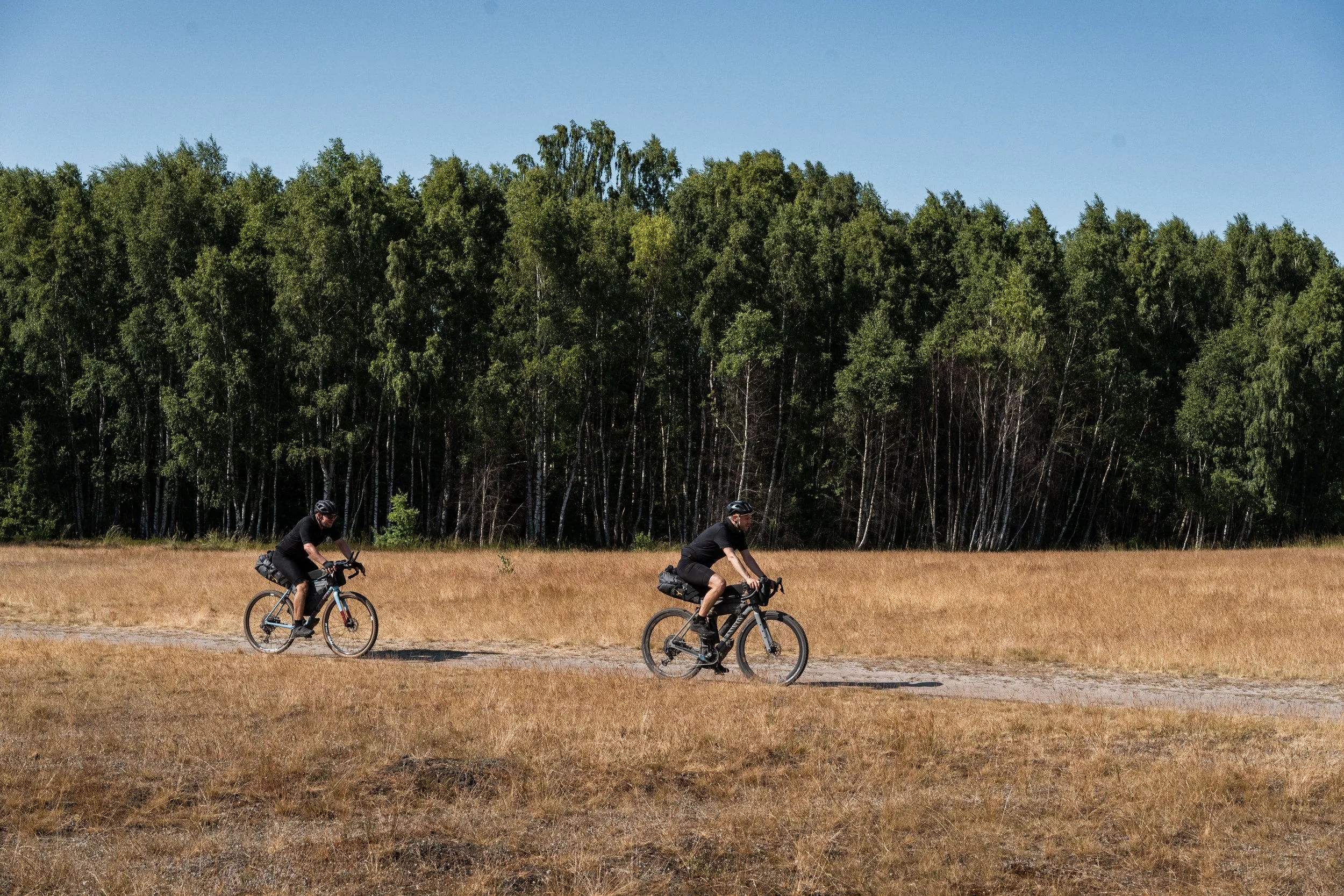



After a short resupply break in a supermarket, we headed towards the Baltic Sea. The coastline was bathed in beautiful soft sunset light, as we were flying over paved bike lanes towards Boltenhagen, our last stop before the night. On the last kilometers, we were joined by Sebastian Stoll, who also kept us company for a pizza stop. In the restaurant, we also used the bathroom to get off all the dust, sun screen, sweat and all the small flies, we collected over the day.
Riding into the darkness, we soon reached our bivy spot for the night around midnight: a beautiful place right next to the steep coast in a pine forest. We set up the camp, and after 200 km of riding we fell asleep.





Day 2
Our day started quite early. I woke up around 4.15 am even before my alarm went off. It was already surprisingly bright, and I saw that Nils was already up as well. Thus, as the sun was rising we packed our gear and started the second and longest day of our trip.
Before breakfast, we continued on single trails and sandy sections along the coastline towards the city of Wismar.





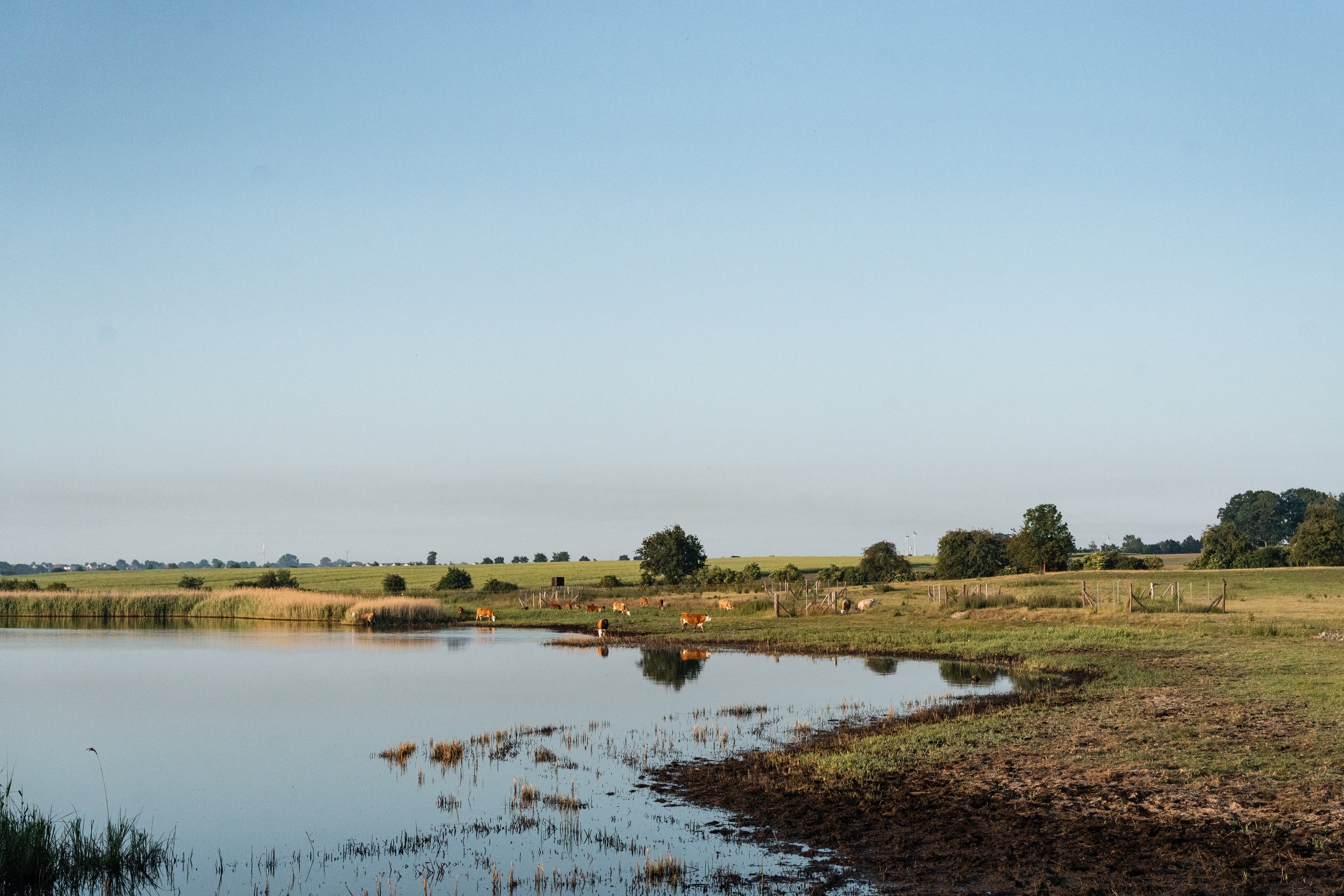
In Wismar, we finally found a bakery that was already open. After cheese sandwiches and coffee we kept riding towards the Mecklenburgische Seenplatte, a district with a huge network of lakes surrounded by forest. I call it the »Canada of Germany«.
The terrain got more and more difficult to ride on. Sandy trails, bumpy roads and steep ramps were taking us more time than we had expected. Additionally, the dry and hot weather made it even more exhausting. All three of us experienced a few »lows«, which luckily were compensated by our positive and supporting group spirit. With an extra bit of sarcasm and silliness we always got ourself motivated again for the next stretch.
I had very little experience riding sand, especially on a gravel bike. Therefore, I was slightly afraid of riding it with higher speeds. After a few sand sections and falling off the bike twice, I decided to accept my fate and go for it. After this day, I would be better at riding sand and maybe I also liked it a little bit more.

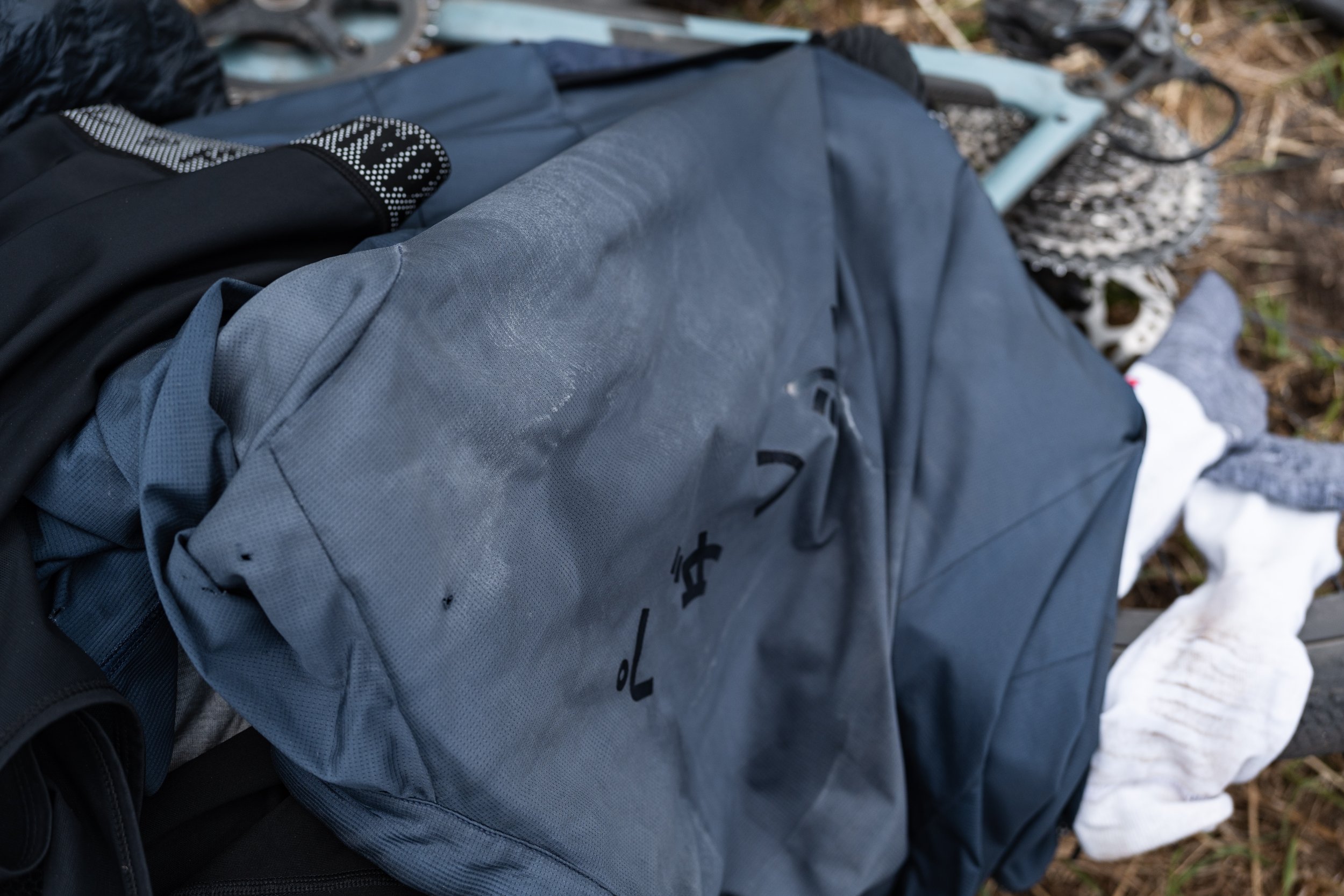



I don’t know how, but with two stops for a swim in the lake and a lot of snack breaks we somehow managed to conquer over 200 km again.
Tired and with pain in the hands and butts we were riding into the sunset. As it got dark, we deiced to call it a day and found a nice bivy spot under some trees next to a field.
Day 3
Again, we started our third and last day quite early. At 4.30 am, my alarm interrupted my deep sleep in the bivy bag. The sun showed up, but only to be covered by clouds shortly afterwards.
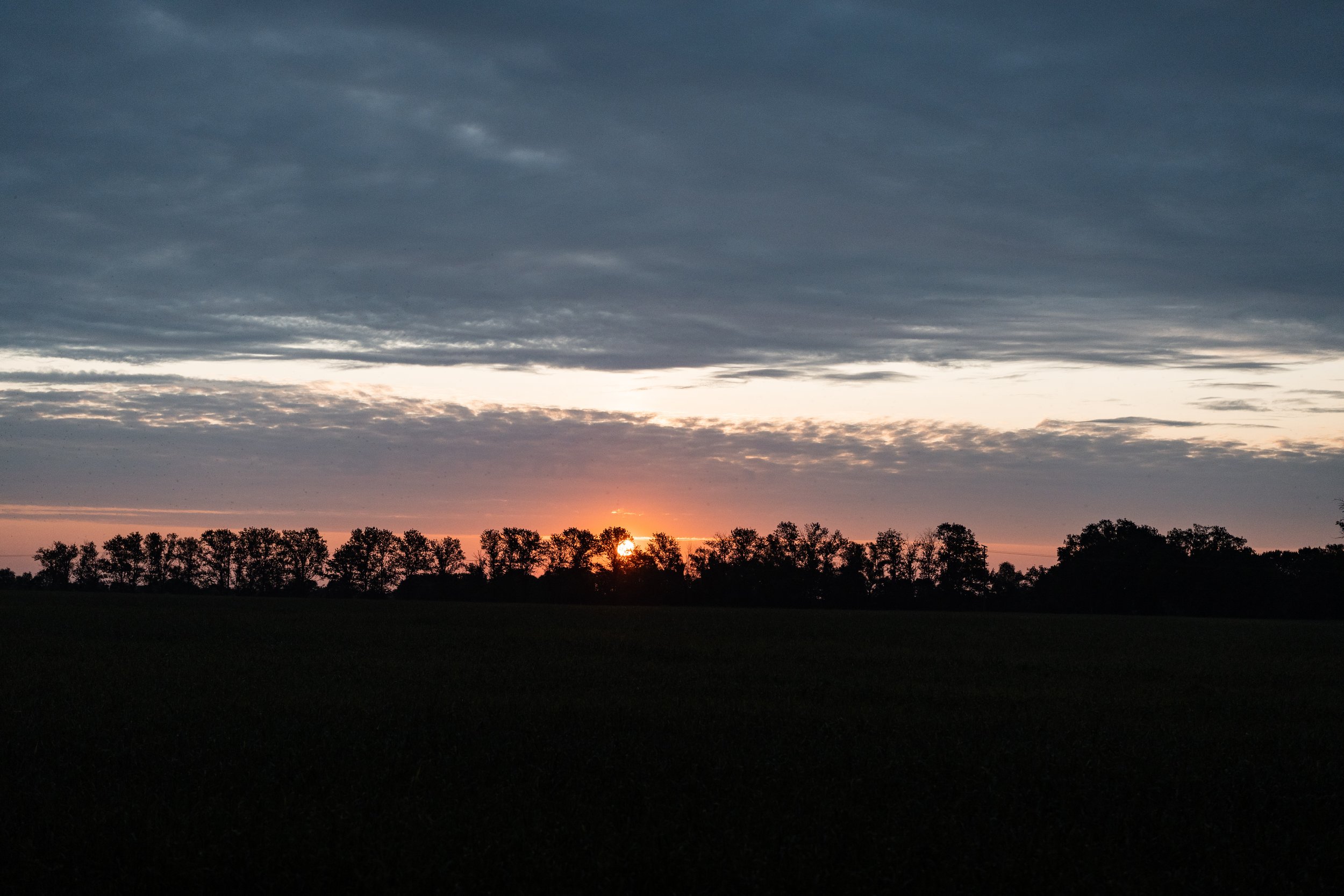


After the hot temperatures the days before, the cloudy weather and light drizzle was a welcome change. After breakfast at kilometer 20 and a resupply in the supermarket, we started towards the finale of our trip. The third day had way more tarmac than the days before. After a short sandy root trail next to a channel, we got onto the Elberadweg, a bike route following the dike next to the Elbe river. With an average of 25-30 km/h we got into a different kind of flow. For the first time you could turn off your head and just pedal.



In the afternoon the weather got hot again, and we noticed the fatigue that came from the past days. Still, we kept our pace and enjoyed the highlights along the route.
We passed by the towns of Boizenburg and Lauenburg and the rode across the high riverbank of the Elbe river, leading us to Hamburg.




The last kilometers felt like an eternity, but after 55 hours we finally reached our starting point Hamburg again. Tired but happy, we packed our bikes into the van and headed back home to Kiel with a head full of memories.
Gran Guanche Gravel Audax — Ultra Bikepacking across the Canary Islands
A few hundred kilometers off the African main land we’ll find a group of volcanic islands sticking out of the Atlantic ocean. This surreal place ranging from desert-like landscapes over foggy rain forrest to lush pastureland is the home of GranGuanche, a bikepacking route that takes you to the most stunning places on the Canary islands.
A few hundred kilometers off the African mainland we’ll find a group of volcanic islands sticking out of the Atlantic Ocean. This surreal place ranging from desert-like landscapes over foggy rain forest to lush pastureland is the home of GranGuanche, a bike-packing route (or more precisely three routes) that takes you to the most stunning places on the Canary Islands. There is a version for road bikes, MTB, and gravel bikes. For each category, an Audax takes place every year where cyclists around the world gather to ride the route together as fast as possible. The route includes five of the eight populated islands, four ferry rides and accounts for around 700 km from the start in Lanzarote to the finish line in El Hierro. Additionally, you’ll have to climb almost 17000 meters in elevation.
700 km
–
+16,000 m
–
5 islands
–
4 ferries
–
700 km – +16,000 m – 5 islands – 4 ferries –
For my first official ultra cycling event I chose GranGuanche because of the magical and diverse landscape, the logistic challenge with all the ferry schedules, and the promise of a mostly rideable route.
1. Lanzarote – Riding through the night
The GranGuanche Gravel Audax starts at 10 pm in the small town of Órzola in the very north of Lanzarote. Since sunset is around 7 pm in March it’s already pitch dark. Around noon I had already taken a shared taxi from my apartment in the south of Lanzarote to the town. With some other riders, we were having lunch at a fish restaurant and spent some time at the beach before the briefing. Time goes by very slowly when you’re waiting for an ultra event to start, so any distraction is welcome, like picking up your starting kit, checking your GPS tracking device or eating pasta.
At 10 pm the waiting is finally over. All together we’re staring into the night. A swarm of bikes with flashing lights is creeping into the dark night. The first climb is already long and steep. The first riders start pushing the bikes. After a few kilometers into the route, I get into my pace. On the long and rocky descents through the darkness, I’m already confirmed in my decision to ride the route on a hardtail MTB.
Looking back in my memories the first stretch on Lanzarote feels like a dream, where I’m not even sure if it really happened. Due to the loss of orientation and any sense of time, I couldn’t even say how long I’m riding. Nevertheless, I arrive at the harbor in Playa Blanca around 4.30 am after riding around 100 km and climbing 2,000 meters.
I stop right next to a waiting room of the ferry companies and see other riders resting there. I have expected to spend the following hours until the ferry leaves in the cold, so I’m pleasantly surprised by the level of comfort. I inflate my sleeping pad, get out my quilt and lay down on the floor next to the other riders. After almost two hours of sleep, my alarm goes off and reminds me to get ready for the first ferry ride.
The sun is already up and in the beautiful morning light, I roll onto the vessel. Surprisingly, the short rest was more effective than I had expected and I’m in a good mood for the next islands. On the ferry, we grab some breakfast and enjoy the 30 min ride to Fuerteventura.
Photo by Matteo Minelli
2. Fuerteventura – Landing on a desert planet
Most riders are leaving the ferry in a hurry. If they want to catch the 6 or 8 pm ferry to Gran Canaria they have to ride the 160 km and 2,700 m without losing too much time. First of all, I go to a bakery at the harbor to get coffee and cake while all the other participants are already up and away. I’m not in a hurry at all. My plan is to take the ferry the next morning so I have all day to finish Fuerteventura.
After breakfast, I get back on the bike, and after leaving the harbor town the route follows the steep coastline in the northwest of the island. With just a few meters between you and the cliffs, you have the most scenic ride you could imagine. Fine gravel roads alter with washboard roller coaster surfaces, thus I make it a game to find the smoothest line in between. Did I mention I still don’t regret going for the hardtail?
Around noon, I get back on tarmac and in the heat I climb up to Betancuria, a historic town in the mountains. In Pajara I sit down in a cafe to get some proper food. Here I first meet Frank and Frank, two fellow riders from Germany who already met at ultra events before and traveled to the Canary Islands together.
After some burger and coke, I’m ready for the second half of Fuerteventura.
The following kilometers are a constant up and down on chunky gravel roads. I first try to catch up with Frank but after a while he is vanishing in the distance.
In the afternoon I’m back on tarmac and after some seriously steep climbs, I’m finally rewarded with a long descent. Shortly after a sandy section at Sotavento beach, I start to look for a nice place for the night.
It’s almost dark when I find a nice spot at the beach to set up my bivy. I’m instantly falling asleep under the starlit night sky of Fuerteventura. I only get up once in the night. The waves are appearing to come closer to my camp, so I decide to move further from the ocean. In the morning I get up in time to ride the last kilometer to the ferry.
Gran Canaria – the steepest climb of my life
I arrive in Gran Canaria at around 10 am. The city of Las Palmas (and especially the bike lane) is under construction. I’m trying to find my way out as fast as possible. But, the first 40 kilometers are more or less in urban areas. Even though I have some nice descents I’m happy to reach the town of Ingenio where I leave the busy roads and start my climb into the mountains. Meanwhile, it’s noon and the sun is burning down on me. The first part is on tarmac and always around 6-8% elevation. For the first time during the Audax, I put in my headphones to listen to some driving beats for motivation. At a restaurant, the tarmac road ends and the route follows a rocky and very steep »gravel« road altered by a likewise steep slab path. Even with my MTB, I have to push the bike a lot. Looking back at it, this was the hardest part of the entire route for me (mentally and physically). But, ultra cycling is just about »standing it« so I keep on pushing and in the late afternoon I arrive at the top at »Llanos de Pez«.
The views are stunning and while slowly descending on the other side of the top, the clouds are rolling in. The atmosphere is changing rapidly as we ride in and out of the fog. As much as I was struggling on the climb, as happy I’m now to have it done.
Not far from the top I arrive at a finca hostel with a stunning view of the sunset. For the first time, I have the comfort of a bed and a warm shower. After dinner, I’m going straight to bed and fall asleep instantly.
The next morning I’m getting up early. It’s still dark outside and for the descent I put on all my clothing. After a while the sun comes up and because of the constant up and down of the road I’m getting warm. For the final decent I’m leaving the tarmac road again for a chunky and steep gravel road through a deep ravine. It’s super quiet here, with no cars, no people, and nothing to worry about but to stay on the road.
On the last kilometers, while I’m having a sandwich at a cafe, Frank catches up with me and we’re riding together to Agaete to catch the 12 am ferry.
Tenerife — Stunning Landscapes and a very cold night
We arrive in Santa Cruz around noon. I try to get out of the city as fast as possible. Because I had to resupply I’m riding the first kilometer alone. I’m already at the climb to Anaga when I catch up with Jens again. We enjoy the rest of the climb up the lush green mountains together. The weather is a bit chilly and the clouds are hanging low on the mountaintops. After the climb, we start descending to La Laguna on beautiful forest trails.
In La Laguna we are looking for a restaurant to have pasta or pizza. But in the late afternoon the choice of restaurants that are already open is quite limited. We finally find a burger place and order burgers and fries. Jens wants to sleep in La Laguna and start early the next morning but my goal was to go a little further into the island. I want to have more time the next day to enjoy the Teide National Park. With the pressure to catch the only ferry to El Hierro the next day at 5 pm, I don’t want the distance be too long. Fortunately, Frank is also down for a few more kilometers into the night. I have found a natural camping site »La Caldera« on the map which I think is a good milestone and we might even find water and toilets there.
So, we start into the darkness and immersed in conversation the time seems to fly by. We only get an idea of the surrounding forest as we follow the branched path that slowly leads us further up into the Teide National Park. The temperature is dropping as we climb higher and our destination doesn’t seem to come closer. Around midnight all of Frank batteries die. With only one light and one GPS computer we’re struggling to make it further through the night. It feels like the longest 35 km of my life. Around 00:30 am we’re finally reaching the camping site. We’re a little disappointed. Not water, no toilets, no shelters. In the end, we find a close-by picnic place with a roof. Meanwhile, it’s already 3 °C We put all our clothes on and crawl into our bivy bags. Tired and exhausted we fall asleep only to wake up from time to time because we’re freezing.
Only five hours later we’re up again to continue our climb through the sunlit pine forest. The sky is clear, temperatures are moderate and the only thing we hear on this peaceful morning is the sound of our drivetrains. The Teide National Park is a stunning place. Every few kilometers the landscape changes and we discover a new natural wonder.
I'm happy that we don’t have to rush here.
After two coffee breaks we start the 35 km-long descent to Los Cristianos. We still have two hours before the ferry leaves, so we’re having our first pizza of the trip.
El Hierro — An Island off the grid
The crossing to El Hierro is quite shaky. Next to our ferry, we see dolphins jumping as the sun sets at the horizon. It’s already dark as we arrive in El Hierro. There is not much around at the harbor so we start with the climb to Valverde, the capital of the island. On the way up I have the only bonk of the entire Audax. Probably because of the heavy sea, I didn’t feel like eating on the ferry. I immediately grab a muffin from my musette and bring up my blood sugar again. The wind is super strong and almost blows us off our bikes. I don’t know where I get my motivation from. I’m tired, completely wet from sweat but also freezing because of the cold wind. There is little to no motivation left. All I want now is to take a shower and sleep for a few hours. Tomorrow will be another day. I share an accommodation with the two Franks and instantly fall asleep on the couch.
The next morning, my motivation is back. In the darkness, we start and leave the villages in the north. The two Franks are going directly back on the route while a do a little detour to make sure I get back onto the route at the exact same spot where I left it. A little later, I find myself in vivid green pastureland with the sun rising above the green hills. Right and left I’m greeted by goats, chickens and cows.
As I’m done with the first of the two big climbs of the island I catch a glimpse of the El Golfo valley into which I’m descending a short time later on a chunky gravel descent.
I meet Jonas and Simon on the way down. They met just before the event and are riding the Audax together. While looking down at the coast we’re thinking about where to resupply before the second climb. I’ve planned to climb a few hundred meters in elevation away from the route to a mini market in a small town but considering the elevation that is still waiting for me, I’m thinking about alternatives. On the dot watching map I see the two Frank dots standing still just a few kilometers ahead at what is obviously a hotel. In hope of coffee or even breakfast we decide to give this option a try. It’s fair to say, we’re not disappointed. At the Hotel »Balneario Pozo la Salud« stumble into an air-conditioned breakfast room with a buffet that offers everything a hungry rider can wish for. We’re loading our plates and half an hour later we are ready to keep on riding.
We follow along the coast of the El Golfo valley before the second and longest climb starts. Simon and Jonas are setting a good pace which I can’t keep up with. So, I’m struggling on my own in the midday heat. After a while, I find my pace and don’t really want to spot as I catch up with them both while taking a break. Shortly later I’m back on the bike and just before I reach the top of the climb I also meet Frank. The views are amazing up the and I’m happy that I successfully made the last big climb of the whole Audax. The success inspires me to go a little fast on the descent through beautiful pines forest. I enjoy the sun, the wind on my face and the winding road down to the finish line. The feeling that nothing can stop me now takes over and activates some unknown resources.
On March 23rd I reach the finish line after 4 days, 17 hours, and 43 minutes. Just a few minutes later the two Franks, Jonas and Simon arrive at the finish line.
It feels great to finish my first ultra event and I’m grateful that everything went the way I had planned it.
I also realize why events like GranGuanche are so popular. It’s more about the experience than about competition and I’m sure that if I had ridden the route by myself there would be something missing: meeting like-minded people to do things that are a little crazy but a lot of fun.
Me at the finish line
The two Franks
Jonas after finishing the Audax
Alpine Medicine Training in the Alps
Sometimes it’s important to look outside the box, get a new perspective and leave your comfort zone. Regarding my main job as an intern at the end of the second year of training in internal medicine I was at this point. I really like most parts of my job in the hospital but I sometimes lacks the adventurous moments that I’m normally looking for in my photography and travel life.
Sometimes it’s important to look outside the box, get a new perspective and leave your comfort zone. Regarding my main job as a resident at the end of the second year of training in internal medicine I was at this point. I really like most parts of my job in the hospital but I sometimes miss the adventurous moments that I’m normally looking for in my photography and travel life. When I heard about alpine and expedition medicine I was instantly hooked. It offered me a perspective to connect my profession as a doctor with my passion of outdoor sports, traveling and photography.
After some more research I became quickly a member of the German Society of Mountain and Expedition Medicine (BExMed) and signed up for the first of three alpine medicine training courses. The “winter course” focuses on ski touring and ski mountaineering with the associated knowledge of avalanches (rescue), frost bite, hypothermia and traumatology. Together with around 40 colleagues and a group mountain guides we set up base camp at “Heidelberger Hütte” a iconic mountain hut in the Silvretta Alps at the border of Switzerland and Austria.
The day was usually splitted into two parts: In the morning we were in small groups with our mountain guide and left for a ski tour that we had planned the night before. On the way up the mountain we learned about potential dangers, snow layers and navigation. Luckily my ski technique was not fully gone after a two years break from skiing. The conditions were wonderful. Powder snow, sunny weather and a manageable level of avalanche danger.
In the afternoon we were gathering in the hut for lectures from various experts in the fields of meteorology, avalanche science and emergency medicine.
Also, we had different training scenarios for multiple patients being buried by an avalanche. The main challenge there was to coordinate the resources in the group for a fast and efficient rescue.
To sum up, my first experience with alpine medicine really made me to want more. The mix of physical and mental challenges in a beautiful environment made this a fulfilling and enriching week. I’m curious what I can expect in the spiring and summer courses when we get into rock climbing and mountaineering, also passions of mine.
‘Route des Grandes alpes’ — Cycling over 1000 Km across the French alps
Elevation? This had never played a role for me as a cyclist living in northern Germany — until now. The only thing thats in my way, riding from A to B up here is the headwind. So now a new player came on the scene. After my school friend Arnold had suggested the Route des Grandes Alpes, I came to the conclusion that the only way to find out if I like it is to just give it a try.
Elevation? This had never played a role for me as a cyclist living in northern Germany — until now. The only thing thats in my way, riding from A to B up here is the headwind. So now a new player came on the scene. After my school friend Arnold had suggested the Route des Grandes Alpes, I came to the conclusion that the only way to find out if I like it is to just give it a try.
However, in order to not over stress it, we decided to travel light and sleep in hotels. With the smallest gear ratio of 40 in the front and 42 in the rear, the total package shouldn’t be too heavy.
The Route des Grandes Alpes was originally planned as a panoramic route for cars and motorcycles, but is also very popular among cyclists. The route officially starts at Lake Geneva and then leads over numerous Alpine passes to the French Mediterranean coast. I want to mention up front that we have not kept to the original route and have chosen small detours from time to time.
To warm up a bit, we started our tour in Freiburg and rode the first two days through southern Germany and Switzerland. It wasn't until the third day that we crossed the border into France, leaving Lake Geneva behind and heading towards Morzine.
We reached our hotel just in time before a heavy thunderstorm with downpours hit us. The next two days the weather should remain somewhat hazy and changing quickly. Since the climbing was unsurprisingly demanding, the somewhat cooler weather was in our favor. Especially the climb to the Col du Colombiére on the fourth day I will never forget. After we had already climbed the Col de Joux Plane on this day, this second pass, which was getting steeper towards the summit, was waiting for us. I remember burning legs and lungs on the last kilometers. At the top, however, a beautiful view and a mystical foggy atmosphere awaited us and after a short break with power bars and Coke we were almost restored.
After the cooler and humid days, the weather became a bit more summery again and during our ascent to Val d'Isere we had a great view of the surrounding mountain landscape. The weather window should hold and so we started the next day in beautiful sunshine to one of the highest points of our tour: For Col de l'Iseran at 2770 m altitude. The rest of the day consisted mostly of long descents, interrupted only by smaller climbs. However, as the wind got stronger the further we descended to the valley, we had to pedal hard in the end to get to Saint Michel de Maurienne. After a good week on the bike we make here our first break day.
Well recovered we started into the next day. Just past the first pass, I noticed that my tubeless tire on the rear wheel was losing air (it was from a large hole that I had patched in advance and was now ripping open again). All attempts to patch the hole again were unsuccessful in the long run, so I decided to put in a tube.
Maybe it was due to the the increased pressure and thus lower grip, the hypoglycemia or dehydration, or maybe a combination of them all. Anyways, on the following descent from the Col du Galibier, a brief moment of inattention caused me to crash. I went off the road on the uphill side and landed headfirst in a pile of rubble. After the initial shock, I took stock: the cervical spine was compressed and hurt terribly with every movement, as well as a few skin abrasions on hands and shoulders. Fortunately, the gear looked much better. As if by a miracle, the bike had hardly got anything off. Only a cheap windbreaker that I had once bought second hand for little money was torn, the jersey underneath had only a few holes. Luckily I was able to continue our tour as planned.
It came in handy, that the next two stages were a bit shorter anyway. In addition, from now on we focused even more on enjoying the trip. If we liked it somewhere, we stopped, bought a few croissants or sat for a while at a cool mountain stream.
The landscape became more and more ‚Mediterranean‘ and the weather got warmer and warmer. After almost two weeks we finally reached the coast town Menton at the French Rivera. After a day of swimming we kept riding the few remaining kilometers to Nice. I would never imagined it, but I think I will miss the climbing (a bit).
Kungsleden – A Backcountry Ski Tour across freezing Lapland
We want to do a multi-day ski trip across the "Fjell", the Swedish mountain landscape starting in the city of Abisko. For more than a week we will be cut off from civilization. Everything we need we have in the "pulks" (a kind of sled) with us or we will find in one of the self-catering huts of the STF in which we will sleep.
The sun's rays flash through the window into our compartment, the monotonous rattling of the train makes us aware of where we are. We open our eyes and look into a new world: a barren, snow-covered landscape passes us by. We are slowly approaching our destination: Lapland. Two nights before, we boarded the Stena Line from Kiel to Gothenburg, and the night before, in Stockholm, we got onto the night train to Abisko.
Now there are only a few hours left until the end of our climate-friendly journey and we have finally reached our destination.
We want to do a multi-day ski trip across the "Fjell", the Swedish mountain landscape starting in the city of Abisko. For more than a week we will be cut off from civilization. Everything we need we have in the "pulks" (a kind of sled) with us or we will find in one of the self-catering huts of the STF in which we will sleep.
The first day of the tour welcomes us with the most beautiful sunshine. The snow sparkles and the low birch trees sway in the gentle wind. In front of us on the horizon we see the mountains. We follow a frozen river for several kilometers and the further we walk up the valley, the worse the visibility becomes. A few hours later it starts to snow and soon we can see only a few meters. Stoically we follow the markings, standing reliably along the way. In the late afternoon we suddenly see our first hut in the distance. The host welcomes us with warm tea and a piece of chocolate. Just the right thing after the long day in sub-zero temperatures.
Afterwards we get shown the huts. We sleep in the main hut with the lounge and the kitchen. Patiently the host explains the procedures to us. For us city people, who are used to all the advantages of modern society, we are not used to cook on gas, to draw water from a hole in the ice and to heat with wood. However, by the end of the tour we will have mastered the little tricks of hut life perfectly.
Nico and I first make our way to the water hole. Equipped with two water canisters we walk a few steps across the lake. There we find a hole in the thick ice cover. After we have filled the canisters we pull them back to the hut. The hut host directs us to the sauna house. There the water would be needed today. Almost every hut is equipped with a sauna, which is not only wonderful to relax but also the place for body care.
While it is getting dark outside we make our way into the preheated sauna. After we have sweated properly and our bodies are boiling we throw ourselves into the half meter of fresh snow in front of the hut. Exhausted but happy we’re going to sleep this night, listening to the crackling of the fire.
The next morning we see the result of the night's snowfall. The whole landscape is covered with a thick layer of fresh snow. Since we are the first to set out for "Alesjaure", we have to make tracks. Since it is much more exhausting than skiing on a paved path, we take turns with it.
Slowly but steadily we gain altitude. The low birch forest thins out and in front of us stretches the plateau that will be our home for the next few days.
Up here we are much more exposed and the wind sweeps across the barren landscape. In every break we have to be careful not to cool down immediately. Quickly we have to slip into our warm expedition down jackets to stay warm.
Although the skiing has a quite meditative character, we try to make regular breaks. Otherwise, it would be too easy to forget to drink or to refill with food.
The huts of the next days always seem like an oasis in the snowy desert. With their black wood they represent a stark contrast to the otherwise pure white landscape. In addition to the guests, there is always a hut host on site to welcome you. But you also get to know the other guests better and better over the week. Since we all ski the same stages pretty much, we meet in the evening again cooking in the living area of the huts.
After just a few days, you're completely into the rhythm of skiing and hut life, as if you've been doing it for ages. No electricity, no running water, no cell phone reception. Life as it was a hundred years ago doesn't feel so bad. We have more time for our thoughts, live more consciously somehow.
That's why it feels strange when we return to civilization after more than a week. After a little over 100 kilometers we reach the village of Nikkaluokta. From here we start our way home.
Lapland was an incredible experience. This majestic expanse, this untouched nature, which is both rough and tender at the same time is imcomparable to anything I have seen so far. And I have a hunch that there is still much to discover here.
Rock climbing in Mallorca
Mallorca is without doubt one of the most popular holiday destinations. Unfortunately the image of the island is characterized by the well know mass tourism spots and drinking hordes of German and British tourists. This kind of distracts from the beautiful and down to earth parts of the island, the great outdoors and climing areas you can find on Mallorca. It’s fair to say I was pleasantly surprised visiting Mallorca for the first time ever.
Mallorca is without doubt one of the most popular holiday destinations. Unfortunately the image of the island has suffered from mass tourism in the past decades. This distracts from the beautiful and down to earth parts of the island, the great outdoors and epic climbing areas you can find on Mallorca. It’s fair to say I was pleasantly surprised visiting Mallorca for the first time ever.
We were lucky to stay with friends of Theresa and other climbers who are also into climbing. Thus, we had great company for the week.
La Creveta
On the first day we went to ‘La Creveta’ a spot in the very northern part of the island, close to the city of Port de Pollença. The approach includes a lot of scrambling and it’s a bit tricky to find your way around the big boulders. But when you finally get to the wall it’s totally worth it. You have a great view on the city and in the afternoon you'll get some sun at the wall.
Cala Romantica
This is one of the scenic spots right at the sea on the east coast. You’ll be belaying right next to the cliff and the sun will burn you all day. The rock is quite sharp since the routes a pretty new but at the same time the bolts are also quite new and trustworthy.
Mont Port
The spot is located close to Port Andratx in the south-eastern part of Mallorca. This spot is famous for the ‘panorama route’, a beautiful route which is by the way great for taking pictures of the climber (in this case me).
Santanyí
On our last day just before heading towards the airport we went to an awesome spot close to Santanyí. From the parking lot next to a lighthouse you walk down a few steps and find a lot of well-bolted routes. Not far away you can also visit the iconic Es Pontàs where Chris Sharma climbed the famous deep water solo route ‘King Line’.
My Bikepacking Gear List
I was asked several times what I bring for my bikepacking tours. So I decided to put up a list of the stuff I’m brining on an average trip. Notice that the gear you need is very dependent on the weather, length of you trip and resupply options. I only use this setup for shot to medium long trips with the possibility of daily resupply with water and food.
I was asked several times what I bring on my bikepacking tours. So, I decided to put up a gear list of an average trip. Notice that the gear you need is very dependent on the weather, length of your trip and resupply options. I only use this setup for short to medium distance trips with daily access to water and food. I don’t bring a tent usually. I’m using shelter huts or my hammock (+ tarp). Furthermore, I don’t bring a cooking system. I will get food from restaurants on my way or eat uncooked food from the supermarkets. For anything more than this (food for several days, tent, etc.), I think bikepacking wouldn’t be the right option and I’d rather choose a rack-with-panniers setup.
On my body
Seat BAG (Apidura Expedition Saddle Pack 17 L)
Sleeping bag (with silk liner)
Light fleece sweater
Merino shirt
Merino underwear
Flip flops
Frame bag (Apidura Expedition Frame Pack 4.5 L)
Repair kit
Pocket knive
Toiletries
Hand pump
Battery pack + charging cable
Handlebar bag (Apidura Expedition Handlebar Pack 14 L)
First aid kit
ACCESSORY bag (Apidura EXPEDITION ACCESSORY POCKET 4.5L)
Snacks
Drone (optional)
Camera
Packable backpack for groceries
Cold Hawaii – Surfing the Danish North Sea
Nørre Vorupør is a small town at the Danish west coast, a place I already knew from my Bikepacking trip to Skagen this summer. This area of Denmark is also called “cold Hawaii” because of the good surfing conditions you’ll find there. Depending on the wind out on the North Sea you get some nice surfable waves.
Nørre Vorupør is a small town at the Danish west coast, a place I already knew from my Bikepacking trip to Skagen this summer. This area of Denmark is also called “cold Hawaii” because of the good surfing conditions you’ll find there. Depending on the wind out on the North Sea you get some nice surfable waves.
We went there for a weekend with a bunch of friends, rented a small house and spent all day at the sea surfing, kite surfing or in my case taking photos with my camera and drone.In the evening we gathered around the oven in our house, had some deliciouse food and a few drinks. This type of breakout from your everyday life is something you need once in a while to recalibrate your inner balance and satisfy your creative mind. Here is a selection of some shots I took during the trip.
Bikepacking Denmark’s west coast to Skagen
If I've learned anything in the past two years, it's that you don't have to go far to experience an adventure. Most of the time you can start right at your own doorstep, with little luggage and without a big budget. Whether it will be an adventure depends much more on your own attitude.
If I've learned anything in the past two years, it's that you don't have to go far to experience an adventure. Most of the time you can start right at your own doorstep, with little luggage and without a big budget. Whether it will be an adventure depends much more on your own attitude.
With the ever-changing travel restrictions, I wanted to make my vacation planning as flexible as possible. Having already ridden across the Danish islands to Copenhagen with my friend Nico in May, I knew that Denmark was the perfect country for bikepacking. This is partly due to the very advanced and consistently good bike infrastructure and partly due to the high density of shelters. These are spread throughout the country and are easy to find via an app. If you can set aside a bit of comfort and enjoy sitting with new people around the campfire, the shelters are the perfect alternative to a tent. Since you only have to take a sleeping mat and a sleeping bag, the total weight is also significantly reduced. Nevertheless, I still had a hammock and a tarp with me, which I ultimately used only once.
My goal was to ride the entire Danish west coast to the northernmost point of Denmark, Skagen. The surface was mostly easy-to-ride tarmac, but there were some longer gravel sections and a few single trails in between, which in retrospect have not been that much fun to ride with the gravel bike. I only found out later: My route planned in Komoot corresponded in many sections to the "Vestkystruten" (West Coast Route), a well-marked bike path that also ends in Skagen. Overall, I would only make minor changes to my route if I’d ride it again.
Due to a raywail strike, I actually started the tour at my front door and rode close to the Danish border, from where I then started the initial tour the next day. The first kilometers behind the border flew by. Most of the time I cycled behind the dike and the route is scenically somewhat monotonous. If you want to skip that, I would rather recommend to start the tour in Esbjerg.
Passig the military training area close to Varde, suddenly the landscape became more scenic. Beautiful heath landscape and pine forests, interspersed with gravel paths provided the most beautiful and diverse part of the first stage.
In the evening I found a nice shelter directly at Ringkøbing Fjord just before Hvide Sande with a few nice people there. So after 175 km, I called it a day.
On the second day the wind increased with gusts up to 30 knots. Fortunately, it came directly from behind and pushed me with full force towards the north.
Shortly after Søndervig, my route then led me over a kilometer-long gravel road with very coarse and loose surface which even with the gravel bike and 40 mm tires made it quite challenging. I passed some other bikers with touring bikes who had quite a hard time. The rest of the day I was more or less on straight tarmac roads, took a ferry at Thyborøn and reached the beautiful Thy National Park with its long dunes, dry forests and moorland. In the evening I found an idyllic shelter not far from the beach. Since it was much too windy for the hammock and the tarp my choice fell again on the shelter.
The next day I reached Klitmøller and Hanstholm, which are very famous spots among surfers. For non-surfers, however, these places have not much to offer besides the beautiful beach. So after a delicious Smørebrød breakfast I kept on riding. I decided to do a little detour to Blubjerg, a limestone cliff from which you have a great view over the coastline. The quite high elevation is by the way a nice distraction from the otherwise rather flat Jutland. Also, the small swerve led me into a relatively short, but quite adventurous intermezzo over some single trails and bridle paths which brought my gravel bike to the limit of „comfortable riding". At the end, however, I hat to grit my teeth and get back on my route.
With just under 100 km, the last day felt more like a rest day after the rather longer days before. I met Cat again, a Frenchwoman who was riding her bike from France to Sweden for a charity project. So I cycled with her for a few kilometers and she told me about her goal to raise money for a project that tries to prevent domestic violence against children. Since the country serves as a model for good child protection, her destination was Sweden.
After a few kilometers, however, I have to keep on racing again and reached Skagen in the early afternoon. I was surprised how beautiful the city was, but of course I had to reach my final destination first. It’s a few kilometers outside the city and the last kilometer you have to push your bike through the sandy beach (spoiler alert: it’s not fun). At the end I am nevertheless pleased that I’m with my bike at the northernmost point of Denmark and see where the North Sea and Baltic Sea meet.
On the train ride home the next day it felt quite strange not to pedal anymore, so I already started dreaming about the next bike-packing tour.






























